
wacat
wacat - Challenge Your Web App with Cat Chaos and AI-Driven Testing!
Stars: 108
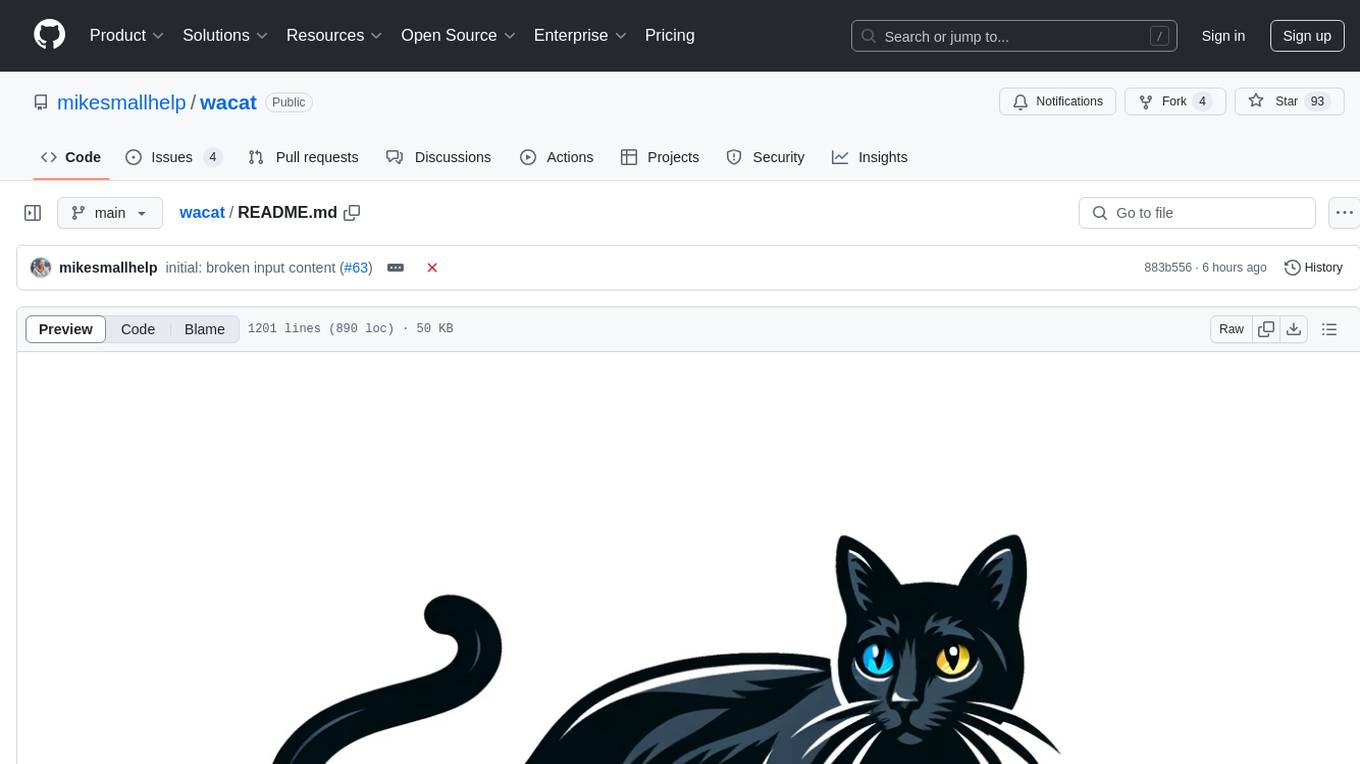
wacat is a tool designed to challenge web applications by simulating chaotic user behavior, such as random navigation, form input, and button clicks. It also incorporates AI-powered error detection, supporting features like detecting error messages, generating AI-driven content, and detecting HTTP errors and console log errors. wacat can be configured for various testing scenarios, including authentication, excluding specific pages, running in headless mode, and setting wait times and timeouts. It is built using TypeScript, oclif, Playwright, and Next.js for test applications.
README:
Imagine, you leave your computer for a while and go to pick up a cup of coffee. Meanwhile, your cat walks over your keyboard and causes some chaos.
wacat (walking cat) application
- Navigates to the root URL of your web application
- Visits every link in your application in a random order
- Inputs random text into forms
- Selects random values from dropdown menus, checkboxes, etc
- Clicks every button in a random order
Additionally, wacat:
- Detects error messages on web pages using AI
- This is an optional feature and requires an OpenAI API key
- Generates AI-driven content for input fields
- Optional feature requiring an OpenAI API key
- Supports generating invalid or broken input content
- Detects HTTP errors (e.g., HTTP 500 errors) between the browser and server
- Detects errors in the browser's console log
- Detects user-defined error messages on web pages
- These error messages are specified in a parameter file
- Use this if AI is not enabled
- Supports user-defined configurations for random form text inputs
- Can read form inputs from external files (e.g., resources like Combined-Wordlists)
- Can focus exclusively on testing links, which is useful for smoke testing your application
- Supports some authentication scenarios
- Authentication configurations are provided in a JSON file
- Allows configuration of pages that should not be visited
- Allows configuration of buttons to avoid pushing
- Adding headers for authentication and other purposes
- Supports a headless mode
- Allows configuration of page download wait times and overall test timeout values
- Supports running in CI pipelines
wacat uses the Playwright tool internally. It is tested to work on Windows, Linux, and Mac.
If you encounter a bug or need a specific feature, please create a new issue.
The current version of wacat is 1.5.4. Please refer to the end of this page for the change history.
Please ensure you only test your own web application or have explicit permission to test someone else’s application. Testing the vulnerabilities of an application without authorization could be illegal.
The application is designed to stay within the host you are testing. However, as this is a hobby project, unexpected behavior is possible. It's important to monitor wacat's actions and use Ctrl + C to stop the process if it navigates to an unintended page.
Additionally, if your application requires authentication and your wacat authentication configuration is incorrect or incompatible, it could lead to issues such as account lockouts. wacat could also potentially disrupt your application's database or other components. For these reasons, it is strongly recommended to use wacat only in a testing environment.
Install Node.js from here. wacat has been tested and verified to work with Node.js version 20 on Linux, Mac, and Windows.
Clone the wacat repository, navigate to the wacat folder, and run the following command:
npm install && npx playwright install --with-deps && npm run build && npm install -g
Note: You may be prompted for your password when running the above command, as the Playwright tool is installed globally.
If you want to use AI for error detection (see details below), add your OpenAI API key and model to a .env file:
OPENAI_API_KEY=<your key here>
OPENAI_API_MODEL=<your model here>
Important: Providing an OpenAI API key will result in charges from OpenAI for API usage. While wacat has been thoroughly tested, please be aware that programming errors could lead to a higher-than-expected number of calls to the OpenAI API.
Additionally, please note that if your website contains sensitive material, the contents of your pages will be sent to the OpenAI API, and you must ensure that this aligns with your intended use. For example, it is possible that the content you send may be used as training data.
You can also add the following optional environment variable to the .env file:
MAX_PAGE_CONTENT_CHARS=<your value here>
This value sets the maximum number of characters sent to the OpenAI API for error detection. The default is 3000 if not specified. See additional details below.
You can optionally use the following environment variable:
AI_GENERATED_INPUT_TEXTS=true
When set to true, the OpenAI API will generate values for all input fields on each page. By default, this value is set to false. Please note that enabling this option can result in significant API usage. Therefore, it is recommended to have at least a Tier 1 usage plan, as it allows for a higher number of requests per minute compared to the Free tier. Using the Free tier plan is possible, but it may be very slow if there are numerous OpenAI API calls.
To update wacat to the latest version, run:
git pull && npm install && npx playwright install --with-deps && npm run build && npm i -g
Run the following command in the wacat folder:
wacat test <your url>
For example, the command:
wacat test https://mikesmallhelp-test-application.vercel.app/
tests a simple application at the URL https://mikesmallhelp-test-application.vercel.app/. The application includes the following pages:
First, the wacat application opens the Chromium browser and navigates to the root URL provided in the command:
The root page does not contain any input fields, dropdown menus, or similar elements. wacat simply collects links to the two subpages and visits them. On each subpage, wacat performs the following actions:
- Presses the button
- Fills the form fields, selects options from dropdown menus, etc.
- Presses the button again
Here is the command for you to copy, paste, and run. You can follow the same process to run all other examples. Feel free to experiment with the provided test applications.
wacat test https://mikesmallhelp-test-application.vercel.app/
Testing in url: https://mikesmallhelp-test-application.vercel.app/. Please wait...
Running 1 test using 1 worker
[chromium] › test.spec.ts:41:1 › test an application
In the page: https://mikesmallhelp-test-application.vercel.app/
In the page: https://mikesmallhelp-test-application.vercel.app/working-page2
Push the button #1
Filling the #1 text input field a value: _k6AKNU3z"{=myqS.K
The label is 'Your Date of Birth Here', so generating an appropriate random content for the input field
Filling the #2 text input field a value: 16/09/2004
The #1 drop-down list. Selecting the option #2
Selecting the #1 checkbox
The #1 radio button group. Selecting the radio button #3
Filling the #1 email input field a value: [email protected]
Filling the #1 password input field a value: A#1!!a#!#AaA!A
Filling the #1 search input field a value: SZOmqATkrV
Filling the #1 url input field a value: https://nrebn.com
Push the button #1
In the page: https://mikesmallhelp-test-application.vercel.app/working-page
Push the button #1
Filling the #1 text input field a value: _k6AKNU3z"{=myqS.K
The label is 'Your Date of Birth Here', so generating an appropriate random content for the input field
Filling the #2 text input field a value: 16/09/2004
The #1 drop-down list. Selecting the option #2
Selecting the #1 checkbox
The #1 radio button group. Selecting the radio button #2
Filling the #1 email input field a value: [email protected]
Filling the #1 password input field a value: aa2B#1aA!##2A#!AaA
Filling the #1 search input field a value: lSjsBVOzkhCC
Filling the #1 url input field a value: https://vpo7ut.net
Push the button #1
1 passed (24.3s)
Note: The default wait time for each page is 5000 milliseconds. To adjust this wait time, use the --wait flag (see details later).
Here is an example application that contains an error message, "An unexpected error occurred! Please try again after some time.", on one of its subpages:
If you provide an OpenAI API key (see above), wacat can use AI to detect error messages like this on the page.
For example, run the command:
wacat test https://mikesmallhelp-test-application-error-in-page.vercel.app/
The command output might look like this:
Testing in url: https://mikesmallhelp-test-application-error-in-page.vercel.app/. Please wait...
› Error:
› Error occurred: Command failed: ROOT_URL='https://mikesmallhelp-test-application-error-in-page.vercel.app/' npx playwright test --project=chromium --headed
› + stderr: + stdout:
› Running 1 test using 1 worker
[chromium] › test.spec.ts:45:1 › test an application
› In the page: https://mikesmallhelp-test-application-error-in-page.vercel.app/
Check with the AI that the page doesn't contain errors.
In the page: https://mikesmallhelp-test-application-error-in-page.vercel.app/working-page
Check with the AI that the page doesn't contain errors.
Push the button #1
Check with the AI that the page doesn't contain errors.
Filling the #1 text input field a value: AyXoEJ_Sd$(7+JqeROkD
The #1 drop-down list. Selecting the option #2
Push the button #1
Check with the AI that the page doesn't contain errors.
In the page: https://mikesmallhelp-test-application-error-in-page.vercel.app/error-text-in-page
Check with the AI that the page doesn't contain errors.
1) [chromium] › test.spec.ts:45:1 › test an application ──────────────────────────────────────────
›
› AssertionError: The AI detected that current page contains error, the page contents are: Test page An unexpected error occurred! Please try again after some time.
›
› 162 | console.log(errorMessage);
› 163 | } else {
› > 164 | fail(errorMessage);
› | ^
› 165 | }
› 166 | }
› 167 | }
›
› at checkPageForErrors (/home/lenovo/projektit/wacat/e2e-tests/test.spec.ts:164:17)
› at handlePage (/home/lenovo/projektit/wacat/e2e-tests/test.spec.ts:127:5)
› at visitLinks (/home/lenovo/projektit/wacat/e2e-tests/test.spec.ts:507:13)
› at handlePage (/home/lenovo/projektit/wacat/e2e-tests/test.spec.ts:137:5)
› at /home/lenovo/projektit/wacat/e2e-tests/test.spec.ts:78:5
›
1 failed
› [chromium] › test.spec.ts:45:1 › test an application ───────────────────────────────────────────
When wacat uses AI, it logs the message:
Check with the AI that the page doesn't contain errors.
for every page.
If the AI detects an error, wacat logs a message like this (see the error message above):
The AI detected that current page contains error, the page contents are: Test page An unexpected error occurred! Please try again after some time.
To log AI errors without halting the test, use the --bypass-ai-errors flag. For example:
wacat test --bypass-ai-errors https://mikesmallhelp-test-application-error-in-page.vercel.app/
The OpenAI API has rate limits based on your organization's subscription. For example, if you see an error like this:
Error: 429 Rate limit reached for *** in organization
› ************ on requests per min (RPM): Limit 3, Used 3,
› Requested 1. Please try again in 20s.
use the --wait parameter (as explained below) to slow down wacat's requests. You may also need to adjust the test timeout using the --timeout parameter (as explained below).
For daily request limits, such as:
Error: 429 Rate limit reached for *** in organization
› ************ on requests per day (RPD): Limit 200, Used
› 200, Requested 1. Please try again in 7m12s.
wait for the limit to reset, and then rerun wacat.
If your queries exceed the API's tokens-per-minute limit, you can use the MAX_PAGE_CONTENT_CHARS .env variable (see above) to control the number of characters wacat sends per page to the API for analysis.
The base prompt contains approximately 1600 characters. For example, if you set MAX_PAGE_CONTENT_CHARS to 400, the total prompt size will be around 2000 characters, or roughly 500 tokens (1 token is approximately 4 characters in English). The response will always consist of a single token, so primarily manage the prompt size.
For more details, refer to https://help.openai.com/en/articles/4936856-what-are-tokens-and-how-to-count-them.
The AI can generate content for HTML input fields based on the type, autocomplete, or placeholder attributes of the input element. It can also use the field's label content to assist in generating the input. This feature can be enabled by setting the AI_GENERATED_INPUT_TEXTS environment variable (refer to the details above).
Here’s an example of an application page:
If you run the following command:
wacat test https://mikesmallhelp-test-application-simple.vercel.app/
The output might look like this:
Testing in url: https://mikesmallhelp-test-application-simple.vercel.app/. Please wait...
Running 1 test using 1 worker
[chromium] › test.spec.ts:50:1 › test an application
In the page: https://mikesmallhelp-test-application-simple.vercel.app/
Check with the AI that the page doesn't contain errors.
In the page: https://mikesmallhelp-test-application-simple.vercel.app/test-page
Check with the AI that the page doesn't contain errors.
Push the button #1
Check with the AI that the page doesn't contain errors.
Filling the #1 input field with the AI, type: text, autocomplete: no autocomplete, placeholder: no placeholder, label: Email, the generated value: [email protected]
Filling the #2 input field with the AI, type: text, autocomplete: cc-number, placeholder: no placeholder, label: no label, the generated value: 4532 9876 5432 1234
Filling the #3 input field with the AI, type: no type, autocomplete: no autocomplete, placeholder: 01/01/1990, label: no label, the generated value: 15/07/1985
Push the button #1
Check with the AI that the page doesn't contain errors.
1 passed (1.7m)
In the lines:
Filling the #1 input field with the AI, type: text, autocomplete: no autocomplete, placeholder: no placeholder, label: Email, the generated value: [email protected]
Filling the #2 input field with the AI, type: text, autocomplete: cc-number, placeholder: no placeholder, label: no label, the generated value: 4532 9876 5432 1234
Filling the #3 input field with the AI, type: no type, autocomplete: no autocomplete, placeholder: 01/01/1990, label: no label, the generated value: 15/07/1985
you can see that the AI automatically generated the content for the input fields based on their type and label.
wacat can generate input values that are broken in various ways and to varying degrees for testing purposes. The level of brokenness can range from
inputs with only minor errors to deliberately highly broken inputs that may contain multiple inconsistencies or severe issues.
If the AI_GENERATED_INPUT_TEXTS environment variable is set to true (refer to the details above), AI is used to generate input texts.
Example of a simple application page:
The following commands are identical in syntax, regardless of whether AI is used. For example, if AI is enabled and the following command is executed:
wacat test --broken-input-values https://mikesmallhelp-test-application-simple.vercel.app/
The output might look like this:
Testing in url: https://mikesmallhelp-test-application-simple.vercel.app/. Please wait...
Running 1 test using 1 worker
[chromium] › test.spec.ts:50:1 › test an application
In the page: https://mikesmallhelp-test-application-simple.vercel.app/
Check with the AI that the page doesn't contain errors.
In the page: https://mikesmallhelp-test-application-simple.vercel.app/test-page
Check with the AI that the page doesn't contain errors.
Push the button #1
Check with the AI that the page doesn't contain errors.
Filling the #1 input field with the AI, type: text, autocomplete: no autocomplete, placeholder: no placeholder, label: Email, the generated value: test@example,com (the broken input value used)
Filling the #2 input field with the AI, type: text, autocomplete: cc-number, placeholder: no placeholder, label: no label, the generated value: 5221-4823-76$$--02345-8823####slkfjddl (the broken input value used)
Filling the #3 input field with the AI, type: no type, autocomplete: no autocomplete, placeholder: 01/01/1990, label: no label, the generated value: 01/.01.199ama9🔥💥🥴¾⅓⅔🗺️👂🎉😤🚀🛸🌌 (the broken input value used)
Push the button #1
Check with the AI that the page doesn't contain errors.
1 passed (1.8m)
In this example, the broken input values are clearly indicated in the output with the text (the broken input value used). Examples include:
- A broken email address:
test@example,com - A broken credit card's number:
5221-4823-76$$--02345-8823####slkfjddl - A broken date:
01/.01.199ama9🔥💥🥴¾⅓⅔🗺️👂🎉😤🚀🛸🌌
If you want only a portion of the input values to be broken, you can use the --broken-input-values-percentage flag. This flag allows you to specify a percentage (0-100) of inputs to be intentionally broken or invalid. For instance, setting this flag to 34 means approximately 34% of inputs will be invalid.
For example:
wacat test --broken-input-values --broken-input-values-percentage 34 https://mikesmallhelp-test-application-simple.vercel.app/
This command might produce the following output:
Testing in url: https://mikesmallhelp-test-application-simple.vercel.app/. Please wait...
Running 1 test using 1 worker
[chromium] › test.spec.ts:50:1 › test an application
In the page: https://mikesmallhelp-test-application-simple.vercel.app/
Check with the AI that the page doesn't contain errors.
In the page: https://mikesmallhelp-test-application-simple.vercel.app/test-page
Check with the AI that the page doesn't contain errors.
Push the button #1
Check with the AI that the page doesn't contain errors.
Filling the #1 input field with the AI, type: text, autocomplete: no autocomplete, placeholder: no placeholder, label: Email, the generated value: test@example,com@@@jjd (the broken input value used)
Filling the #2 input field with the AI, type: text, autocomplete: cc-number, placeholder: no placeholder, label: no label, the generated value: 4539 4512 0390 4573
Filling the #3 input field with the AI, type: no type, autocomplete: no autocomplete, placeholder: 01/01/1990, label: no label, the generated value: 15/08/1985
Push the button #1
Check with the AI that the page doesn't contain errors.
1 passed (1.7m)
In this case, only the value test@example,com@@@jjd is broken, while the other inputs 4539 4512 0390 4573 and 15/08/1985 remains valid. This demonstrates how the --broken-input-values-percentage flag controls the proportion of invalid inputs.
By fine-tuning this parameter, you can simulate real-world scenarios where some user inputs may be erroneous or malformed.
wacat can detect HTTP errors occurring between the browser and the server. For example, in the application shown below, clicking the button triggers an HTTP 500 error:
You can test this scenario with the following command:
wacat test https://mikesmallhelp-test-application-http-500-error.vercel.app/
The command output might look like this:
Testing in url: https://mikesmallhelp-test-application-http-500-error.vercel.app/. Please wait...
› Error:
› Error occurred: Command failed: ROOT_URL='https://mikesmallhelp-test-application-http-500-error.vercel.app/' npx playwright test --project=chromium --headed
› + stderr: + stdout:
› Running 1 test using 1 worker
[chromium] › test.spec.ts:40:1 › test an application
› In the page: https://mikesmallhelp-test-application-http-500-error.vercel.app/
In the page: https://mikesmallhelp-test-application-http-500-error.vercel.app/working-page
Push the button #1
Filling the #1 text input field a value: 4trK*edD
The #1 drop-down list. Selecting the option #2
Push the button #1
In the page: https://mikesmallhelp-test-application-http-500-error.vercel.app/api-returns-http-500
Push the button #1
In the page: https://mikesmallhelp-test-application-http-500-error.vercel.app/api-returns-http-500: Request to https://mikesmallhelp-test-application-http-500-error.vercel.app/api/http-500 resulted
› in status code 500
In the page: https://mikesmallhelp-test-application-http-500-error.vercel.app/api-returns-http-500: Found an error message in the browser's console: Failed to load resource: the server responded
› with a status of 500 ()
In the page: https://mikesmallhelp-test-application-http-500-error.vercel.app/api-returns-http-500: Found an error message in the browser's console: Error fetching data: Error: Network response was
› not ok
› at r (https://mikesmallhelp-test-application-http-500-error.vercel.app/_next/static/chunks/pages/api-returns-http-500-d6a108dd102494f7.js:1:1402)
› at async n (https://mikesmallhelp-test-application-http-500-error.vercel.app/_next/static/chunks/pages/api-returns-http-500-d6a108dd102494f7.js:1:735)
1) [chromium] › test.spec.ts:40:1 › test an application ──────────────────────────────────────────
›
› AssertionError: In the page: https://mikesmallhelp-test-application-http-500-error.vercel.app/api-returns-http-500: Request to
› https://mikesmallhelp-test-application-http-500-error.vercel.app/api/http-500 resulted in status code 500
›
› 51 |
› 52 | if (!bypassHttpErrors) {
› > 53 | fail(message);
› | ^
› 54 | }
› 55 | }
› 56 | });
›
› at Page.<anonymous> (/home/lenovo/projektit/wacat/e2e-tests/test.spec.ts:53:17)
›
1 failed
› [chromium] › test.spec.ts:40:1 › test an application
In this example, wacat detects the HTTP 500 error, logs it with "1 failed," and stops execution. The specific error message is:
AssertionError: In the page: https://mikesmallhelp-test-application-http-500-error.vercel.app/api-returns-http-500: Request to
› https://mikesmallhelp-test-application-http-500-error.vercel.app/api/http-500 resulted in status code 500
To prevent wacat from stopping execution on HTTP errors, use the --bypass-http-errors flag. For example:
wacat test --bypass-http-errors https://mikesmallhelp-test-application-http-500-error.vercel.app/
In this case, wacat logs the HTTP 500 error but continues the test execution without stopping.
Here is an example application where one subpage contains the error text:
An unexpected error occurred! Please try again after some time.
In this example, we configure wacat to detect the error text "An unexpected error occurred! Please try again after some time." We also want wacat to detect the error text "abc". This configuration is added to a JSON file as follows:
{
"errorTextsInPages": ["abc", "An unexpected error occurred! Please try again after some time."]
}
The run command to use this JSON configuration file (via the --conf flag) is as follows:
wacat test --conf example-files\configuration-error-texts.json https://mikesmallhelp-test-application-error-in-page.vercel.app
wacat test --conf example-files/configuration-error-texts.json https://mikesmallhelp-test-application-error-in-page.vercel.app
The command output is:
Testing in url: https://mikesmallhelp-test-application-error-in-page.vercel.app. Please wait...
» Error:
» Error occurred: Command failed: set ROOT_URL=https://mikesmallhelp-test-application-error-in-page.vercel.app && set CONFIGURATION_FILE_PATH=example-files\configuration-error-texts.json && npx playwright test --project=chromium
» --headed
» + stderr: + stdout:
» Running 1 test using 1 worker
[chromium] › test.spec.ts:45:1 › test an application
» In the page: https://mikesmallhelp-test-application-error-in-page.vercel.app/
Check that the page doesn't contain the abc text
Check that the page doesn't contain the An unexpected error occurred! Please try again after some time. text
In the page: https://mikesmallhelp-test-application-error-in-page.vercel.app/error-text-in-page
Check that the page doesn't contain the abc text
Check that the page doesn't contain the An unexpected error occurred! Please try again after some time. text
1) [chromium] › test.spec.ts:45:1 › test an application ──────────────────────────────────────────
»
» Error: expect(received).not.toContain(expected) // indexOf
»
» Expected substring: not "An unexpected error occurred! Please try again after some time."
» Received string: "Test page An unexpected error occurred! Please try again after some time."
»
» 177 | for (const errorText of configuration.errorTextsInPages) {
» 178 | console.log(`Check that the page doesn't contain the ${errorText} text`);
» > 179 | expect(content).not.toContain(errorText);
» | ^
» 180 | }
» 181 | }
» 182 |
»
» at checkPageForErrors (C:\repot\wacat\e2e-tests\test.spec.ts:179:29)
» at handlePage (C:\repot\wacat\e2e-tests\test.spec.ts:127:5)
» at visitLinks (C:\repot\wacat\e2e-tests\test.spec.ts:507:13)
» at handlePage (C:\repot\wacat\e2e-tests\test.spec.ts:137:5)
» at C:\repot\wacat\e2e-tests\test.spec.ts:78:5
»
1 failed
» [chromium] › test.spec.ts:45:1 › test an application ───────────────────────────────────────────
In this scenario, wacat detects the error text "An unexpected error occurred! Please try again after some time." on one subpage. It reports the error with the message "1 failed" and halts execution.
Here is an example application that logs an error in the browser's console:
When the following command is run:
wacat test https://mikesmallhelp-test-application-error-in-browser-console.vercel.app
the execution stops when an error is detected in the browser's console:
Testing in url: https://mikesmallhelp-test-application-error-in-browser-console.vercel.app. Please wait...
› Error:
› Error occurred: Command failed: ROOT_URL='https://mikesmallhelp-test-application-error-in-browser-console.vercel.app' WAIT=2000 npx playwright test --project=chromium --headed
› + stderr: + stdout:
› Running 1 test using 1 worker
[chromium] › test.spec.ts:40:1 › test an application
› In the page: https://mikesmallhelp-test-application-error-in-browser-console.vercel.app/
In the page: https://mikesmallhelp-test-application-error-in-browser-console.vercel.app/working-page
Push the button #1
Filling the #1 text input field a value: q52<<r`k`bZzP<Jua#53RAn)cKg0&K14
The #1 drop-down list. Selecting the option #2
Push the button #1
In the page: https://mikesmallhelp-test-application-error-in-browser-console.vercel.app/error-in-browser-console: Found an error message in the browser's console: Hello! Something wrong!
1) [chromium] › test.spec.ts:40:1 › test an application ──────────────────────────────────────────
›
› AssertionError: In the page: https://mikesmallhelp-test-application-error-in-browser-console.vercel.app/error-in-browser-console: Found an error message in the browser's console: Hello!
› Something wrong!
›
› 62 |
› 63 | if (!bypassBrowserConsoleErrors && !bypassHttpErrors) {
› > 64 | fail(message);
› | ^
› 65 | }
› 66 | }
› 67 | });
›
› at Page.<anonymous> (/home/lenovo/projektit/wacat/e2e-tests/test.spec.ts:64:17)
›
1 failed
› [chromium] › test.spec.ts:40:1 › test an application
In this example, wacat logs the message:
Found an error message in the browser's console: Hello! Something wrong!
and stops execution.
If you want wacat to bypass this check and continue execution despite browser console errors, use the --bypass-browser-console-errors flag. For example:
wacat test --bypass-browser-console-errors https://mikesmallhelp-test-application-error-in-browser-console.vercel.app
In this case, wacat logs the error message but does not stop execution, continuing the test instead.
By default, wacat generates random form inputs with lengths ranging between 1 and 60 characters, using a default character set. You can customize these settings as follows:
- Use the flag --random-input-texts-min-length to set the minimum length of the random input
- Use the flag --random-input-texts-max-length to set the maximum length of the random input
- Use the flag --random-input-texts-charset to specify the character set for the random input
Here is an example command and its output:
wacat test --random-input-texts-min-length 1 --random-input-texts-max-length 3 --random-input-texts-charset ®©¥¬¿ https://mikesmallhelp-test-application.vercel.app/
Testing in url: https://mikesmallhelp-test-application.vercel.app/. Please wait...
Running 1 test using 1 worker
[chromium] › test.spec.ts:41:1 › test an application
In the page: https://mikesmallhelp-test-application.vercel.app/
In the page: https://mikesmallhelp-test-application.vercel.app/working-page
Push the button #1
Filling the #1 text input field a value: ®
Filling the #2 text input field a value: ®
Filling the #3 text input field a value: ®
Filling the #4 text input field a value: ®
Filling the #5 text input field a value: ®
Filling the #6 text input field a value: ®
The #1 drop-down list. Selecting the option #2
Selecting the #1 checkbox
The #1 radio button group. Selecting the radio button #3
Push the button #1
In the page: https://mikesmallhelp-test-application.vercel.app/working-page2
Push the button #1
Filling the #1 text input field a value: ®
Filling the #2 text input field a value: ®
Filling the #3 text input field a value: ®
Filling the #4 text input field a value: ®
Filling the #5 text input field a value: ®
Filling the #6 text input field a value: ®
The #1 drop-down list. Selecting the option #2
Selecting the #1 checkbox
The #1 radio button group. Selecting the radio button #2
Push the button #1
1 passed (54.0s)
In this example, wacat generates random strings using the character set ®©¥¬¿. The generated strings have lengths between 1 and 3 characters.
It is also possible to configure wacat to read input field texts from a file. For example, consider the file example-files/input-texts.txt with the following contents:
xaxa
ybyb
wacat uses each line from the file as input for the fields in the target application, unless an error occurs or the page changes.
The command to run this with a local file on Windows is:
wacat test --input-texts example-files\input-texts.txt https://mikesmallhelp-test-application.vercel.app/
On Linux and Mac, the command is:
wacat test --input-texts example-files/input-texts.txt https://mikesmallhelp-test-application.vercel.app/
To use a remote file, the command is:
wacat test --input-texts https://raw.githubusercontent.com/mikesmallhelp/wacat/main/example-files/input-texts.txt https://mikesmallhelp-test-application.vercel.app/
All these commands produce the following output:
Testing in url: https://mikesmallhelp-test-application.vercel.app/. Please wait...
Running 1 test using 1 worker
[chromium] › test.spec.ts:41:1 › test an application
In the page: https://mikesmallhelp-test-application.vercel.app/
In the page: https://mikesmallhelp-test-application.vercel.app/working-page
Push the button #1
Filling the #1 text input field a value: xaxa
Filling the #2 text input field a value: xaxa
Filling the #3 text input field a value: xaxa
Filling the #4 text input field a value: xaxa
Filling the #5 text input field a value: xaxa
Filling the #6 text input field a value: xaxa
The #1 drop-down list. Selecting the option #2
Selecting the #1 checkbox
The #1 radio button group. Selecting the radio button #3
Push the button #1
Filling the #1 text input field a value: ybyb
Filling the #2 text input field a value: ybyb
Filling the #3 text input field a value: ybyb
Filling the #4 text input field a value: ybyb
Filling the #5 text input field a value: ybyb
Filling the #6 text input field a value: ybyb
The #1 drop-down list. Selecting the option #2
Selecting the #1 checkbox
The #1 radio button group. Selecting the radio button #1
Push the button #1
In the page: https://mikesmallhelp-test-application.vercel.app/working-page2
Push the button #1
Filling the #1 text input field a value: xaxa
Filling the #2 text input field a value: xaxa
Filling the #3 text input field a value: xaxa
Filling the #4 text input field a value: xaxa
Filling the #5 text input field a value: xaxa
Filling the #6 text input field a value: xaxa
The #1 drop-down list. Selecting the option #2
Selecting the #1 checkbox
The #1 radio button group. Selecting the radio button #1
Push the button #1
Filling the #1 text input field a value: ybyb
Filling the #2 text input field a value: ybyb
Filling the #3 text input field a value: ybyb
Filling the #4 text input field a value: ybyb
Filling the #5 text input field a value: ybyb
Filling the #6 text input field a value: ybyb
The #1 drop-down list. Selecting the option #2
Selecting the #1 checkbox
The #1 radio button group. Selecting the radio button #3
Push the button #1
1 passed (1.1m)
As shown in the output, the values from the file input-texts.txt (xaxa and ybyb) are used as inputs.
You can test using different input text files, such as those available at https://github.com/0xspade/Combined-Wordlists?tab=readme-ov-file.
When using a large input text file, set an appropriately high value for the --timeout parameter to ensure smooth execution. wacat has been successfully tested with a file containing 5000 lines against a simple test application.
To test only the links in an application, use the --only-links flag. With this option, wacat loads the pages and detects errors but does not fill input fields or interact with other elements.
Here is an example command and its output:
wacat test --only-links https://mikesmallhelp-test-application.vercel.app/
Testing in url: https://mikesmallhelp-test-application.vercel.app/. Please wait...
Running 1 test using 1 worker
[chromium] › test.spec.ts:40:1 › test an application
In the page: https://mikesmallhelp-test-application.vercel.app/
In the page: https://mikesmallhelp-test-application.vercel.app/working-page
In the page: https://mikesmallhelp-test-application.vercel.app/working-page2
1 passed (14.7s)
Here is an example of an application with simple authentication:
wacat can perform authentication for this application using the following JSON configuration file:
{
"authentication": {
"usernameLabel": "Username",
"usernameValue": "Mike",
"passwordLabel": "Password",
"passwordValue": "Smallhelp",
"loginButtonLabel": "Login"
}
}
In this JSON file:
- The application has a label "Username," which is assigned to the "usernameLabel" attribute.
- The value for the username, "Mike," is assigned to the "usernameValue" attribute.
- Similarly, the label "Password" is assigned to "passwordLabel," and the value "Smallhelp" to "passwordValue."
- The login button is labeled "Login," and its label is assigned to the "loginButtonLabel" attribute.
wacat test --conf example-files\configuration-authentication.json https://mikesmallhelp-test-application-simple-authentication.vercel.app/
wacat test --conf example-files/configuration-authentication.json https://mikesmallhelp-test-application-simple-authentication.vercel.app/
Testing in url: https://mikesmallhelp-test-application-simple-authentication.vercel.app/. Please wait...
Running 1 test using 1 worker
[chromium] › test.spec.ts:40:1 › test an application
Filled the username and the password. Pushed the authentication button
In the page: https://mikesmallhelp-test-application-simple-authentication.vercel.app/
In the page: https://mikesmallhelp-test-application-simple-authentication.vercel.app/working-page2
Push the button #1
Filling the #1 text input field a value: =_e6PF[J{u98&QI`DP
The #1 drop-down list. Selecting the option #2
Push the button #1
In the page: https://mikesmallhelp-test-application-simple-authentication.vercel.app/working-page
Push the button #1
Filling the #1 text input field a value: =_e6PF[J{u98&QI`DP
The #1 drop-down list. Selecting the option #2
Push the button #1
1 passed (24.7s)
In the output, the line:
Filled the username and the password. Pushed the authentication button
indicates that wacat successfully completed the authentication process.
Here is an example of an application with a more complex authentication process:
wacat can perform authentication for this application using the following JSON configuration file:
{
"authentication": {
"beforeAuthenticationLinkTexts": [
"Please go to an application",
"Please login"
],
"usernameLabel": "Username",
"usernameValue": "Mike",
"usernameButtonLabel": "Next",
"passwordLabel": "Password",
"passwordValue": "Smallhelp",
"loginButtonLabel": "Login"
}
}
This JSON file is more complex than the one in the previous example:
- The "beforeAuthenticationLinkTexts" attribute lists link texts ("Please go to an application" and "Please login") found on the pages preceding the authentication page.
- The page where the username is entered contains a button labeled "Next," which is assigned to the "usernameButtonLabel" attribute in the JSON.
wacat test --conf example-files\configuration-complicated-authentication.json https://mikesmallhelp-test-application-more-complicated-authentication.vercel.app/
wacat test --conf example-files/configuration-complicated-authentication.json https://mikesmallhelp-test-application-more-complicated-authentication.vercel.app/
Testing in url: https://mikesmallhelp-test-application-more-complicated-authentication.vercel.app/. Please wait...
Running 1 test using 1 worker
[chromium] › test.spec.ts:40:1 › test an application
Filled the username and the password. Pushed the authentication button
In the page: https://mikesmallhelp-test-application-more-complicated-authentication.vercel.app/
In the page: https://mikesmallhelp-test-application-more-complicated-authentication.vercel.app/working-page
Push the button #1
Filling the #1 text input field a value: Agc-QmUBS,Z]zx,~q*:ZNX*?L
The #1 drop-down list. Selecting the option #2
Push the button #1
In the page: https://mikesmallhelp-test-application-more-complicated-authentication.vercel.app/working-page2
Push the button #1
Filling the #1 text input field a value: Agc-QmUBS,Z]zx,~q*:ZNX*?L
The #1 drop-down list. Selecting the option #2
Push the button #1
In the page: https://mikesmallhelp-test-application-more-complicated-authentication.vercel.app/logout
1 passed (28.7s)
wacat is designed to remain within the host you are testing. Additionally, you can configure specific page URLs that should not be visited during the test.
For example, consider the following output from a previous test:
In the page: https://mikesmallhelp-test-application-more-complicated-authentication.vercel.app/logout
If you want to prevent wacat from visiting the logout page, you can use the "notVisitLinkUrls" attribute in the JSON configuration. This attribute lists the URLs that wacat should avoid.
Here is an example JSON configuration:
{
"authentication": {
"beforeAuthenticationLinkTexts": [
"Please go to an application",
"Please login"
],
"usernameLabel": "Username",
"usernameValue": "Mike",
"usernameButtonLabel": "Next",
"passwordLabel": "Password",
"passwordValue": "Smallhelp",
"loginButtonLabel": "Login"
},
"notVisitLinkUrls": [
"https://mikesmallhelp-test-application-more-complicated-authentication.vercel.app/logout"
]
}
wacat test --conf example-files/configuration-complicated-authentication-with-not-visit-link-urls-remote.json https://mikesmallhelp-test-application-more-complicated-authentication.vercel.app/
wacat test --conf example-files/configuration-complicated-authentication-with-not-visit-link-urls-remote.json https://mikesmallhelp-test-application-more-complicated-authentication.vercel.app/
Testing in url: https://mikesmallhelp-test-application-more-complicated-authentication.vercel.app/. Please wait...
Running 1 test using 1 worker
[chromium] › test.spec.ts:40:1 › test an application
Filled the username and the password. Pushed the authentication button
In the page: https://mikesmallhelp-test-application-more-complicated-authentication.vercel.app/
In the page: https://mikesmallhelp-test-application-more-complicated-authentication.vercel.app/working-page2
Push the button #1
Filling the #1 text input field a value: R?nSk,UP(UBO*t'm1^a^7HIv
The #1 drop-down list. Selecting the option #2
Push the button #1
In the page: https://mikesmallhelp-test-application-more-complicated-authentication.vercel.app/working-page
Push the button #1
Filling the #1 text input field a value: R?nSk,UP(UBO*t'm1^a^7HIv
The #1 drop-down list. Selecting the option #2
Push the button #1
1 passed (23.2s)
In the output, you can see that the following line is no longer present:
In the page: https://mikesmallhelp-test-application-more-complicated-authentication.vercel.app/logout
This confirms that wacat successfully excluded the specified page from the test.
The notVisitLinkUrls JSON attribute is used to specify the URLs that wacat should avoid visiting (see above). Similarly, you can configure buttons that wacat should not push by using the following configuration:
{
"doNotPushButtons": ["Logout", "Go to GitHub"]
}
In this example, wacat is configured to avoid pushing buttons labeled "Logout" or "Go to GitHub." Below is an example demonstrating the use of the doNotPushButtons JSON attribute.
If the current wacat authentication methods are not sufficient, you can manually pass authentication cookies or other headers to wacat for testing. Below is an example. Note that authentication headers vary between applications, so using this feature might require detailed investigation. Additionally, headers can be used for purposes beyond authentication.
We’ll use this simple application as an example: https://mikesmallhelp-test-application-nextjs-auth.vercel.app/. The app has a login page and a main page. If a user attempts to access the main page directly, they are redirected to the login page. The credentials are:
Username: [email protected]
Password: password
To extract authentication cookies:
- Log in to the application and navigate to the main page.
- Open the developer console (press Ctrl + Shift + I on most major browsers).
- Go to the Network tab and refresh the page.
- Right-click on the page’s network call and select Copy > Copy as cURL.
If you paste the copied cURL command into a file, it will look similar to this:
curl 'https://mikesmallhelp-test-application-nextjs-auth.vercel.app/' \
-H 'accept: text/html,application/xhtml+xml,application/xml;q=0.9,image/avif,image/webp,image/apng,*/*;q=0.8,application/signed-exchange;v=b3;q=0.7' \
-H 'accept-language: fi-FI,fi;q=0.9,en-US;q=0.8,en;q=0.7' \
-H 'cache-control: max-age=0' \
-H 'cookie: __Host-next-auth.csrf-token=c5cdb7ffda044e90a1a0c75abe0f81dc3c0a04551ab310d79bc85ae3e3602616%7C7f12c58c94ee1a8c8b28b9c0e1c413b56f03e5797e7ed02563b7aba491f512b7; __Secure-next-auth.callback-url=https%3A%2F%2Fmikesmallhelp-test-application-nextjs-auth.vercel.app%2Flogin%3FcallbackUrl%3Dhttps%253A%252F%252Fmikesmallhelp-test-application-nextjs-auth.vercel.app%252F; __Secure-next-auth.session-token=eyJhbGciOiJkaXIiLCJlbmMiOiJBMjU2R0NNIn0..2bHRJrhxsKYaNZSh.0WhBsCMdsHn0WHgRKuJxq8cqvAV8rJQXStCGt_w2xV1yHvmAxJUQScIfweovsrgCO_J-EsGVifCvtaSVqMUhCAfkly0oL4TP12P8ZyfuhnCy0QZpjGOyAz-aWfDBknZocDPkjlRD0i01uix6xYCtS3cvs-yWWtGJgT7beJWk5qGHRIWJ9quQNTEjykYSuA.oKeZedaSh2KJz4_CUc7WpA' \
-H 'priority: u=0, i' \
-H 'referer: https://vercel.com/' \
-H 'sec-ch-ua: "Not A(Brand";v="8", "Chromium";v="132"' \
-H 'sec-ch-ua-mobile: ?0' \
-H 'sec-ch-ua-platform: "Linux"' \
-H 'sec-fetch-dest: document' \
-H 'sec-fetch-mode: navigate' \
-H 'sec-fetch-site: same-origin' \
-H 'sec-fetch-user: ?1' \
-H 'upgrade-insecure-requests: 1' \
-H 'user-agent: Mozilla/5.0 (X11; Linux x86_64) AppleWebKit/537.36 (KHTML, like Gecko) Chrome/132.0.0.0 Safari/537.36'
Copy the value of the cookie header and add it to the wacat configuration file.
Below is an example configuration file that includes the cookie header. It also configures wacat to avoid pressing the "Logout" button during the test.
{
"headers": [{"name": "cookie", "value": "__Host-next-auth.csrf-token=c5cdb7ffda044e90a1a0c75abe0f81dc3c0a04551ab310d79bc85ae3e3602616%7C7f12c58c94ee1a8c8b28b9c0e1c413b56f03e5797e7ed02563b7aba491f512b7; __Secure-next-auth.callback-url=https%3A%2F%2Fmikesmallhelp-test-application-nextjs-auth.vercel.app%2Flogin%3FcallbackUrl%3Dhttps%253A%252F%252Fmikesmallhelp-test-application-nextjs-auth.vercel.app%252F; __Secure-next-auth.session-token=eyJhbGciOiJkaXIiLCJlbmMiOiJBMjU2R0NNIn0..2bHRJrhxsKYaNZSh.0WhBsCMdsHn0WHgRKuJxq8cqvAV8rJQXStCGt_w2xV1yHvmAxJUQScIfweovsrgCO_J-EsGVifCvtaSVqMUhCAfkly0oL4TP12P8ZyfuhnCy0QZpjGOyAz-aWfDBknZocDPkjlRD0i01uix6xYCtS3cvs-yWWtGJgT7beJWk5qGHRIWJ9quQNTEjykYSuA.oKeZedaSh2KJz4_CUc7WpA"}],
"doNotPushButtons": ["Logout"]
}
Here are the commands to run the test:
wacat test --conf example-files\configuration-cookie-header.json https://mikesmallhelp-test-application-nextjs-auth.vercel.app/
wacat test --conf example-files/configuration-cookie-header.json https://mikesmallhelp-test-application-nextjs-auth.vercel.app/
Testing in url: https://mikesmallhelp-test-application-nextjs-auth.vercel.app/. Please wait...
Running 1 test using 1 worker
[chromium] › test.spec.ts:72:1 › test an application
In the page: https://mikesmallhelp-test-application-nextjs-auth.vercel.app/
1 passed (10.7s)
In this example, wacat bypasses the login page by using the cookie from the configuration file, directly accessing the main page.
To run wacat in headless mode (without displaying the browser), use the --headless flag.
An example command is:
wacat test --headless https://mikesmallhelp-test-application.vercel.app/
wacat can be integrated into a CI pipeline using the --headless flag. For an example configuration, see https://github.com/mikesmallhelp/mikesmallhelp-test-passing-run/blob/main/.github/workflows/testing.yaml.
By default, wacat waits 5000 milliseconds for each page to download. You can configure the wait time in milliseconds using the --wait flag.
Here is an example command with a 2000-millisecond wait time:
wacat test --wait 2000 https://mikesmallhelp-test-application.vercel.app/
Note: wacat uses the Playwright tool internally. While Playwright tests can typically wait for specific text on a page, wacat does not know what text to wait for, so it relies on a configurable wait time instead.
By default, the total timeout for the test command is 120 seconds. You can configure the timeout in seconds using the --timeout flag. The minimum timeout value is 1 second.
Here is an example command with a 50-second timeout:
wacat test --timeout 50 https://mikesmallhelp-test-application.vercel.app/
Note: Playwright internally uses milliseconds for timeouts. If the timeout occurs in this example, the output will resemble:
Test timeout of 50000ms exceeded.
To view all available flags, run the following command:
wacat test --help
Test any web application with wacat. The current version is 1.5.4.
USAGE
$ wacat test URL [--broken-input-values] [--broken-input-values-percentage <value>] [--bypass-ai-errors] [--bypass-browser-console-errors] [--bypass-http-errors] [--conf <value>]
[--debug] [--headless] [--ignore-ai-generated-input-texts-in-] [--ignore-ai-in-test] [--input-texts <value>] [--only-links] [--random-input-texts-charset <value>] [--random-input-texts-max-length
<value>] [--random-input-texts-min-length <value>] [--timeout <value>] [--wait <value>]
ARGUMENTS
URL Application url to test, for example: http://localhost:3000
FLAGS
--broken-input-values Enable the generation of invalid or broken input values.
This flag is effective only when the AI_GENERATED_INPUT_TEXTS environment variable is set.
--broken-input-values-percentage=<value> Specify the percentage (0-100) of broken or invalid input values to use when the
--broken-input-values flag is enabled. For example, a value of 50 means that approximately 50% of
the inputs will be intentionally broken or invalid. The default value is 100%, meaning all
inputs will be broken or invalid unless a specific percentage is provided.
--bypass-ai-errors Bypass the AI errors
--bypass-browser-console-errors Bypass the browser console's errors
--bypass-http-errors Bypass the HTTP errors
--conf=<value> Path to the configuration file
--debug Enable debug mode
--headless Headless mode
--ignore-ai-generated-input-texts-in-test In the automatic tests don't generate input texts with the AI
--ignore-ai-in-test In the automatic tests ignore OpenAI API key
--input-texts=<value> Path to the input texts file
--only-links Test only links
--random-input-texts-charset=<value> Random input texts character set
--random-input-texts-max-length=<value> Random input texts max length
--random-input-texts-min-length=<value> Random input texts min length
--timeout=<value> A whole test run timeout in seconds
--wait=<value> A wait in milliseconds to wait a page load
DESCRIPTION
Test any web application with wacat. The current version is 1.5.4.
EXAMPLES
$ wacat test http://localhost:3000
Note: The URL can be placed before or after the flags.
The technology stack for wacat is straightforward:
- TypeScript
- Bash Scripts
- oclif - The Open CLI Framework
- Playwright
- Next.js - Used for test applications
Make your changes, then run:
npm run test && npm run build && npm install -g && ./run-tests.sh
The run-tests.sh script runs all test cases to verify that wacat works correctly. Alternatively, push your changes to the repository and let GitHub Actions execute the tests.
Make your changes, then run:
npm run test && npm run build && npm install -g
There is currently no automated test script like run-tests.sh for Windows. Instead, run:
run-manual-tests.bat
Review the output to ensure everything is working correctly.
Contributions are warmly welcomed! Check the issues page for tasks. If you encounter a bug or need a specific feature, please create a new issue.
If adding a new feature, ensure a test case is included. Check the run-tests.sh file for integration test examples. Consider adding unit tests to improve code reliability.
- Adding headers for authentication and other purposes
- Enhanced AI input field content generation with support for invalid or broken data. Also improved AI-driven content generation to incorporate autocomplete and placeholder attributes of input elements.
- Added optional AI support to generate input field content
- Added optional AI-powered support for detecting errors in page content
- Derives input type from the label and generates appropriate random content
- Added Windows support
- Support for common HTML input types like radio, email, etc.
- Introduced additional flags, such as --random-input-texts-charset
- Bug fixes
- GitHub Actions tests for Mac
For Tasks:
Click tags to check more tools for each tasksFor Jobs:
Alternative AI tools for wacat
Similar Open Source Tools

wacat
wacat is a tool designed to challenge web applications by simulating chaotic user behavior, such as random navigation, form input, and button clicks. It also incorporates AI-powered error detection, supporting features like detecting error messages, generating AI-driven content, and detecting HTTP errors and console log errors. wacat can be configured for various testing scenarios, including authentication, excluding specific pages, running in headless mode, and setting wait times and timeouts. It is built using TypeScript, oclif, Playwright, and Next.js for test applications.
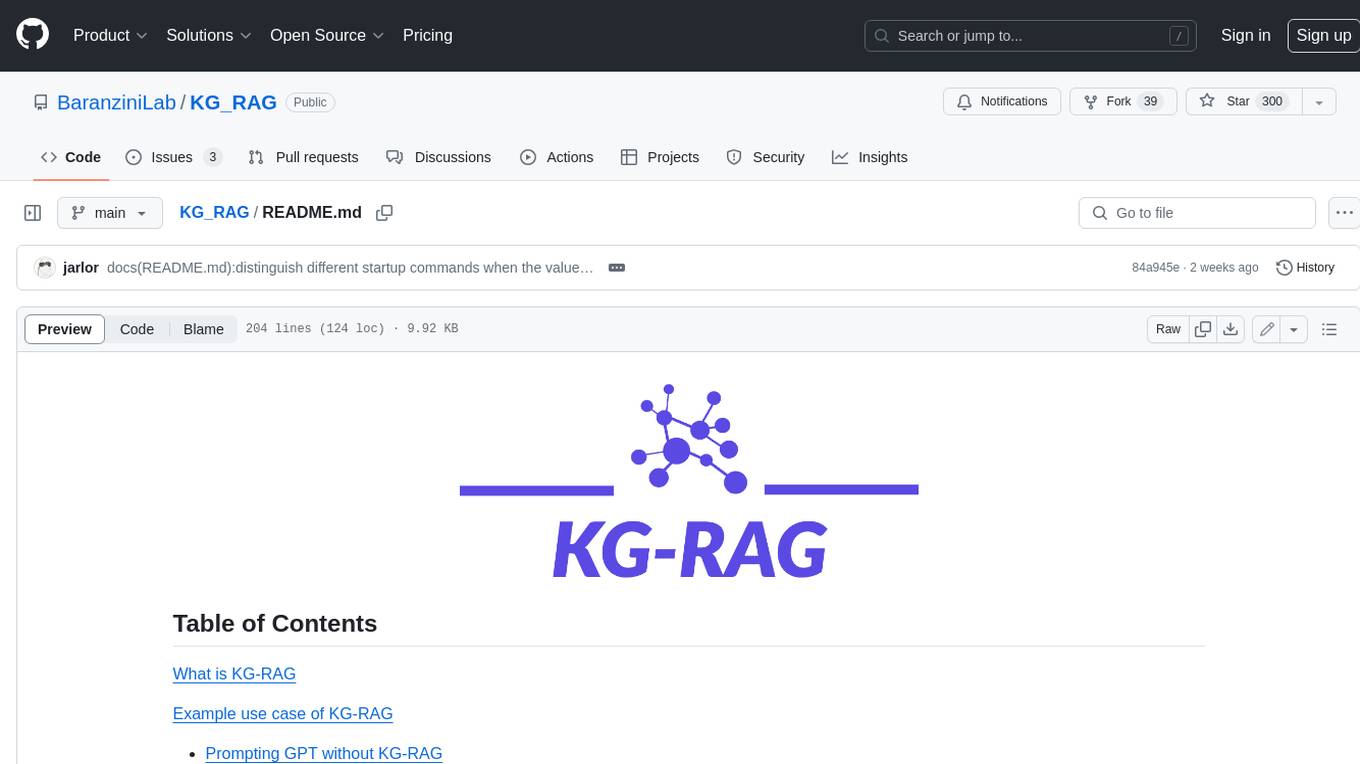
KG_RAG
KG-RAG (Knowledge Graph-based Retrieval Augmented Generation) is a task agnostic framework that combines the explicit knowledge of a Knowledge Graph (KG) with the implicit knowledge of a Large Language Model (LLM). KG-RAG extracts "prompt-aware context" from a KG, which is defined as the minimal context sufficient enough to respond to the user prompt. This framework empowers a general-purpose LLM by incorporating an optimized domain-specific 'prompt-aware context' from a biomedical KG. KG-RAG is specifically designed for running prompts related to Diseases.
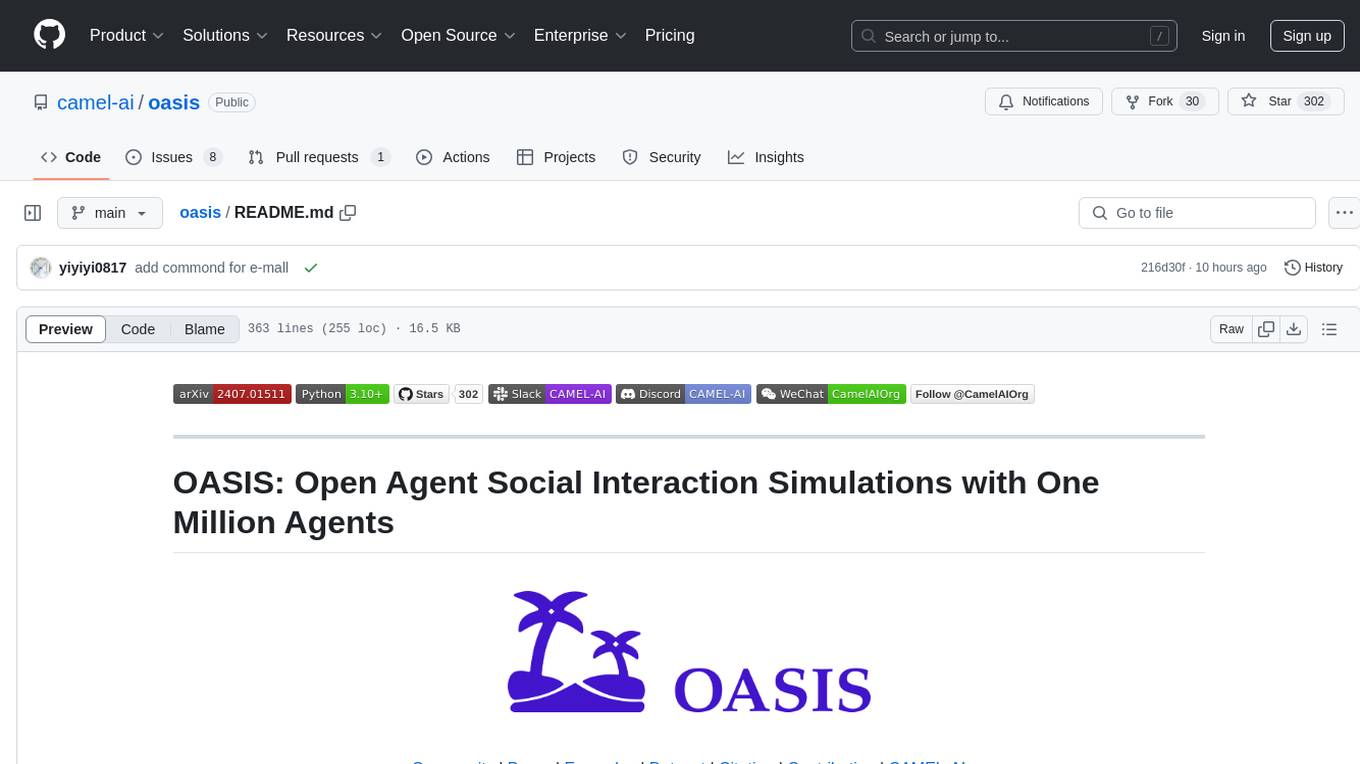
oasis
OASIS is a scalable, open-source social media simulator that integrates large language models with rule-based agents to realistically mimic the behavior of up to one million users on platforms like Twitter and Reddit. It facilitates the study of complex social phenomena such as information spread, group polarization, and herd behavior, offering a versatile tool for exploring diverse social dynamics and user interactions in digital environments. With features like scalability, dynamic environments, diverse action spaces, and integrated recommendation systems, OASIS provides a comprehensive platform for simulating social media interactions at a large scale.
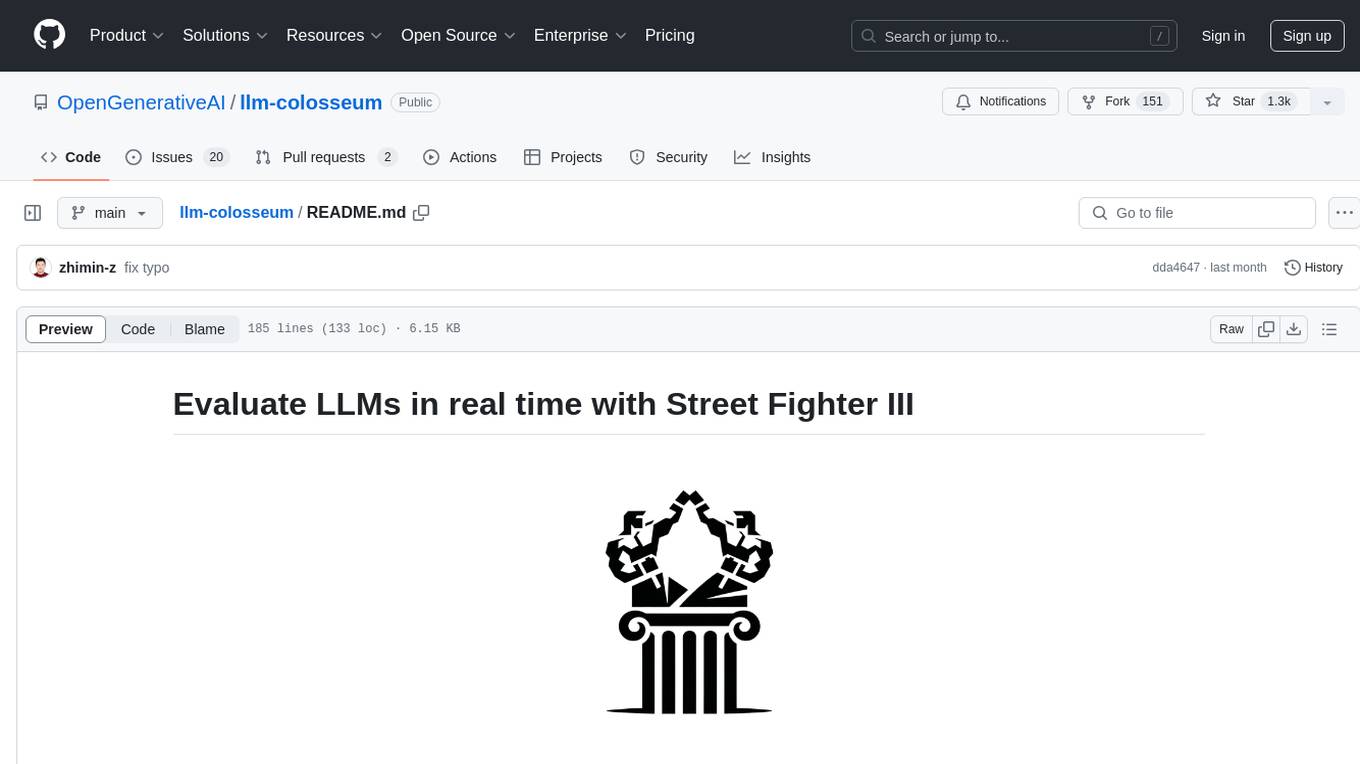
llm-colosseum
llm-colosseum is a tool designed to evaluate Language Model Models (LLMs) in real-time by making them fight each other in Street Fighter III. The tool assesses LLMs based on speed, strategic thinking, adaptability, out-of-the-box thinking, and resilience. It provides a benchmark for LLMs to understand their environment and take context-based actions. Users can analyze the performance of different LLMs through ELO rankings and win rate matrices. The tool allows users to run experiments, test different LLM models, and customize prompts for LLM interactions. It offers installation instructions, test mode options, logging configurations, and the ability to run the tool with local models. Users can also contribute their own LLM models for evaluation and ranking.
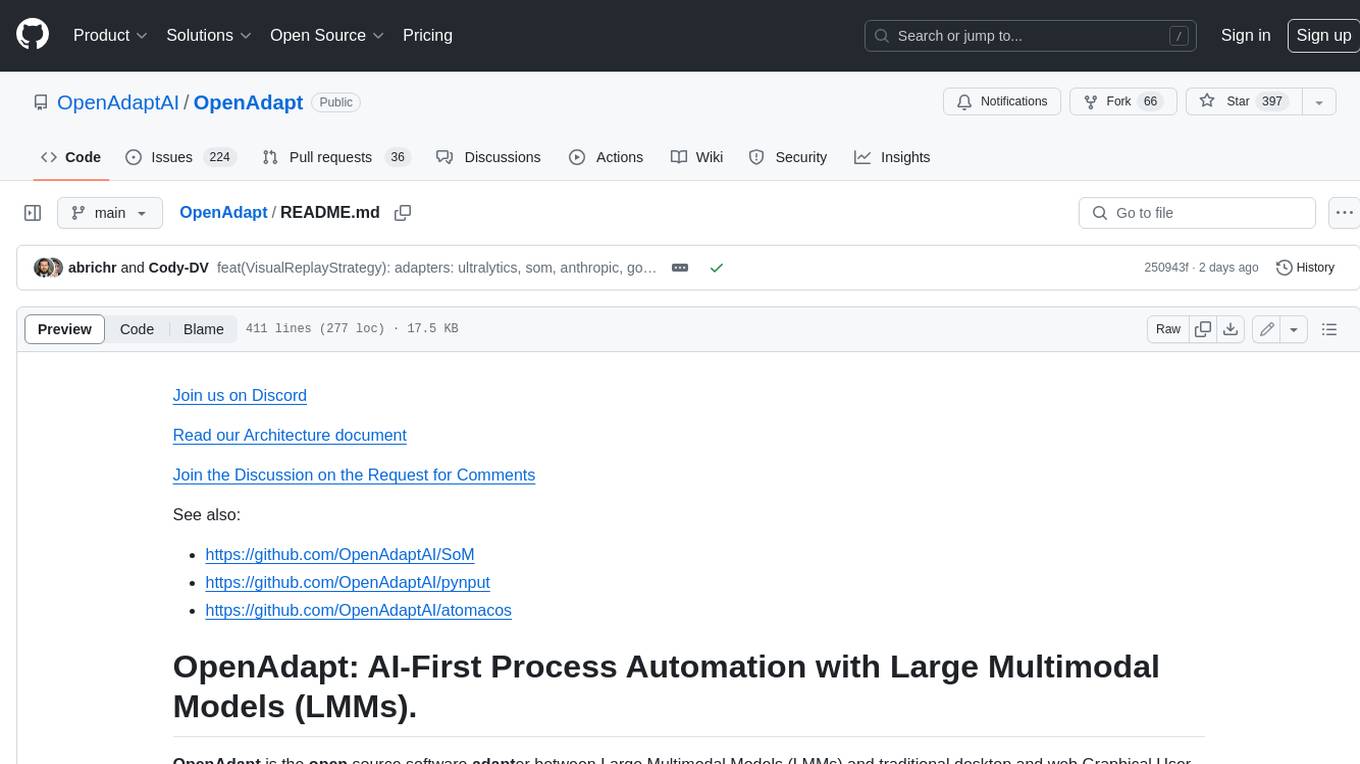
OpenAdapt
OpenAdapt is an open-source software adapter between Large Multimodal Models (LMMs) and traditional desktop and web Graphical User Interfaces (GUIs). It aims to automate repetitive GUI workflows by leveraging the power of LMMs. OpenAdapt records user input and screenshots, converts them into tokenized format, and generates synthetic input via transformer model completions. It also analyzes recordings to generate task trees and replay synthetic input to complete tasks. OpenAdapt is model agnostic and generates prompts automatically by learning from human demonstration, ensuring that agents are grounded in existing processes and mitigating hallucinations. It works with all types of desktop GUIs, including virtualized and web, and is open source under the MIT license.
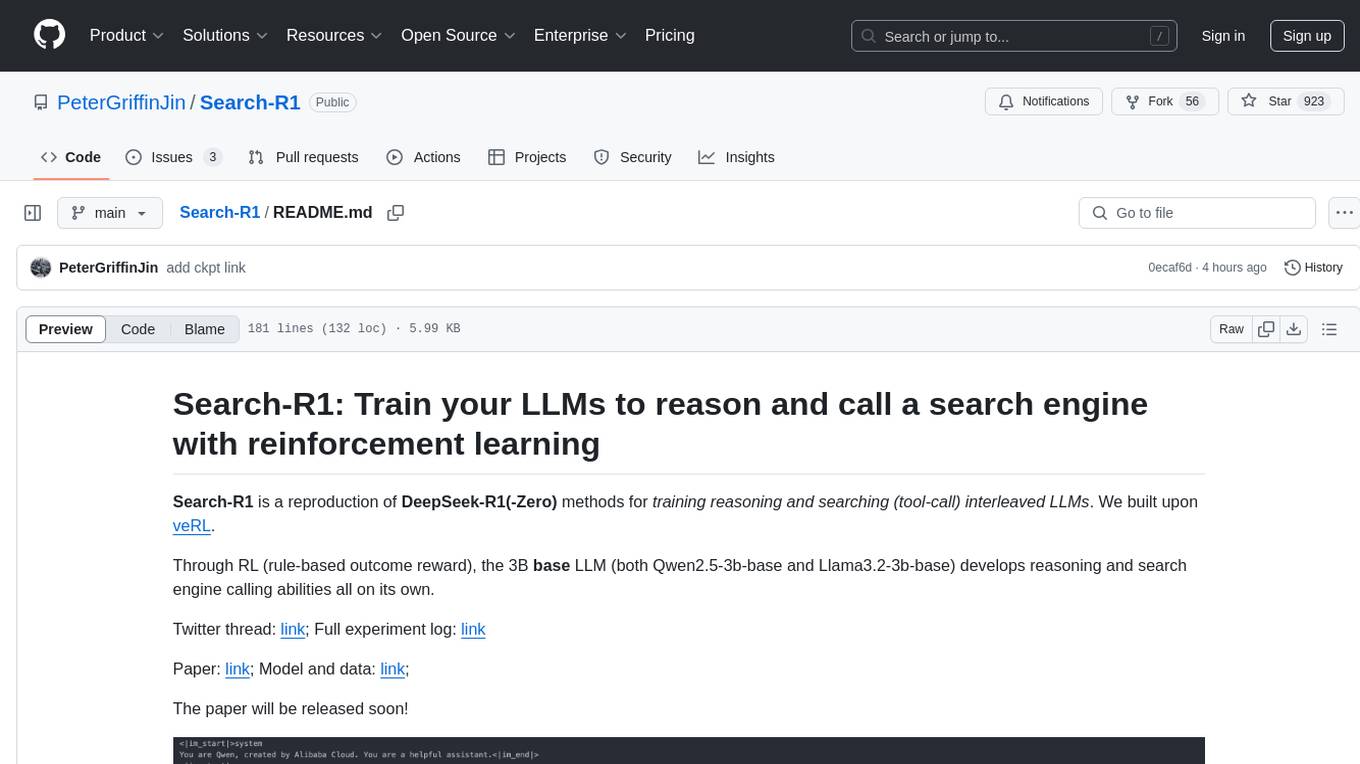
Search-R1
Search-R1 is a tool that trains large language models (LLMs) to reason and call a search engine using reinforcement learning. It is a reproduction of DeepSeek-R1 methods for training reasoning and searching interleaved LLMs, built upon veRL. Through rule-based outcome reward, the base LLM develops reasoning and search engine calling abilities independently. Users can train LLMs on their own datasets and search engines, with preliminary results showing improved performance in search engine calling and reasoning tasks.
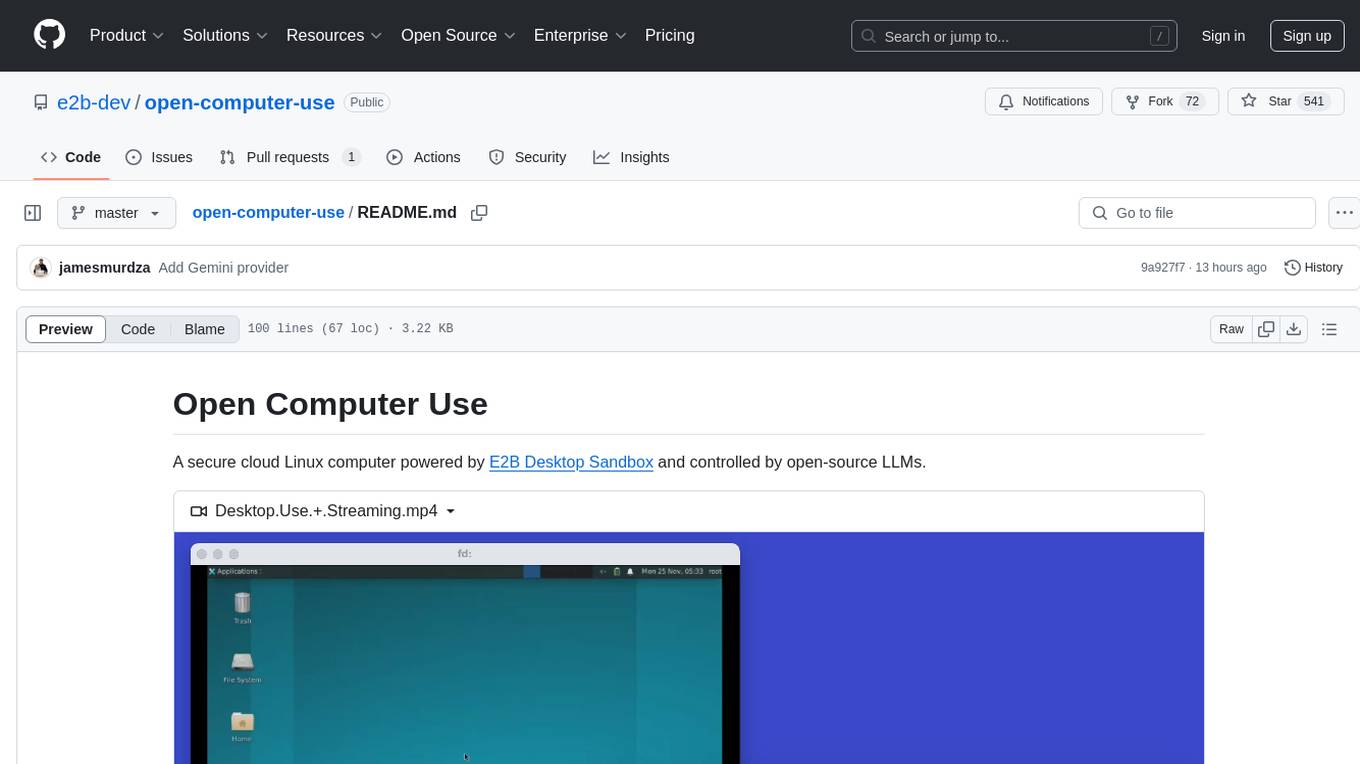
open-computer-use
Open Computer Use is a secure cloud Linux computer powered by E2B Desktop Sandbox and controlled by open-source LLMs. It allows users to operate the computer via keyboard, mouse, and shell commands, live stream the display of the sandbox on the client computer, and pause or prompt the agent at any time. The tool is designed to work with any operating system and supports integration with various LLMs and providers following the OpenAI API specification.
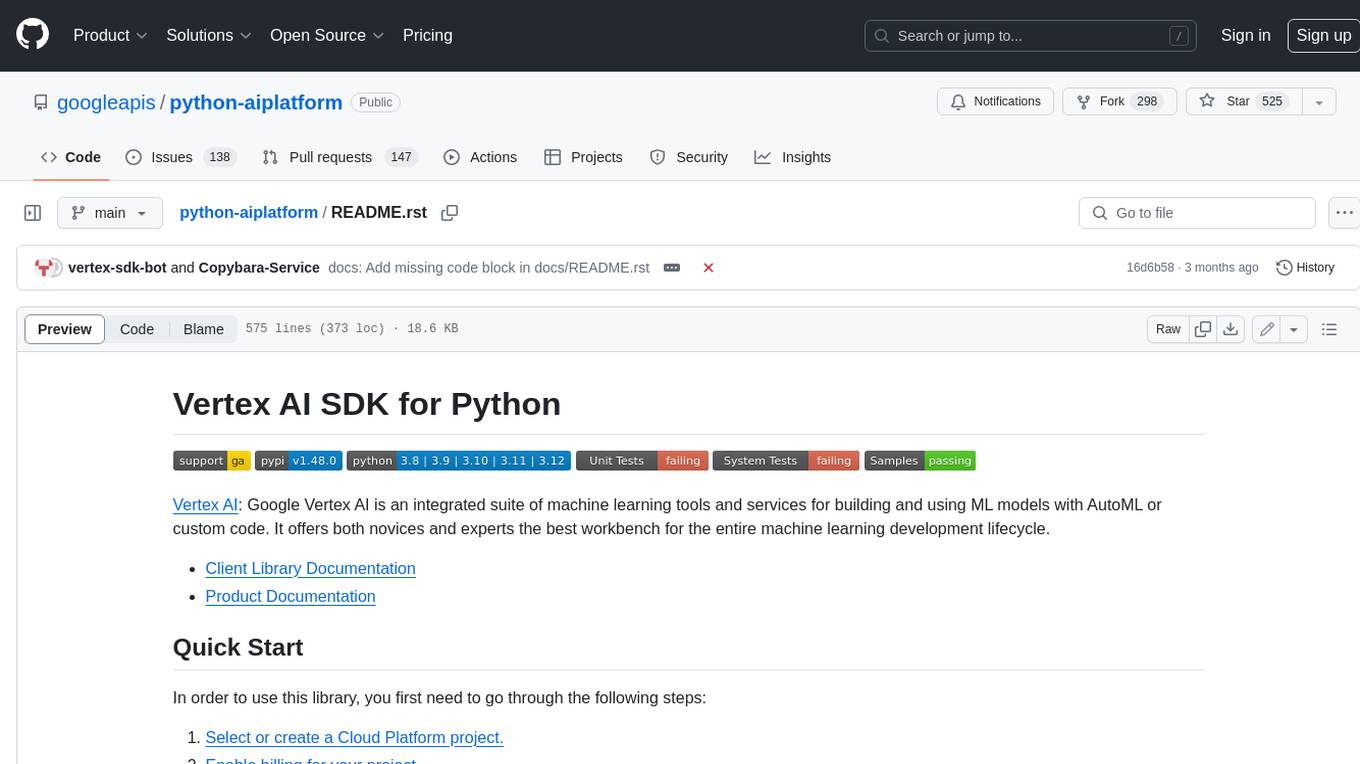
python-aiplatform
The Vertex AI SDK for Python is a library that provides a convenient way to use the Vertex AI API. It offers a high-level interface for creating and managing Vertex AI resources, such as datasets, models, and endpoints. The SDK also provides support for training and deploying custom models, as well as using AutoML models. With the Vertex AI SDK for Python, you can quickly and easily build and deploy machine learning models on Vertex AI.

raglite
RAGLite is a Python toolkit for Retrieval-Augmented Generation (RAG) with PostgreSQL or SQLite. It offers configurable options for choosing LLM providers, database types, and rerankers. The toolkit is fast and permissive, utilizing lightweight dependencies and hardware acceleration. RAGLite provides features like PDF to Markdown conversion, multi-vector chunk embedding, optimal semantic chunking, hybrid search capabilities, adaptive retrieval, and improved output quality. It is extensible with a built-in Model Context Protocol server, customizable ChatGPT-like frontend, document conversion to Markdown, and evaluation tools. Users can configure RAGLite for various tasks like configuring, inserting documents, running RAG pipelines, computing query adapters, evaluating performance, running MCP servers, and serving frontends.
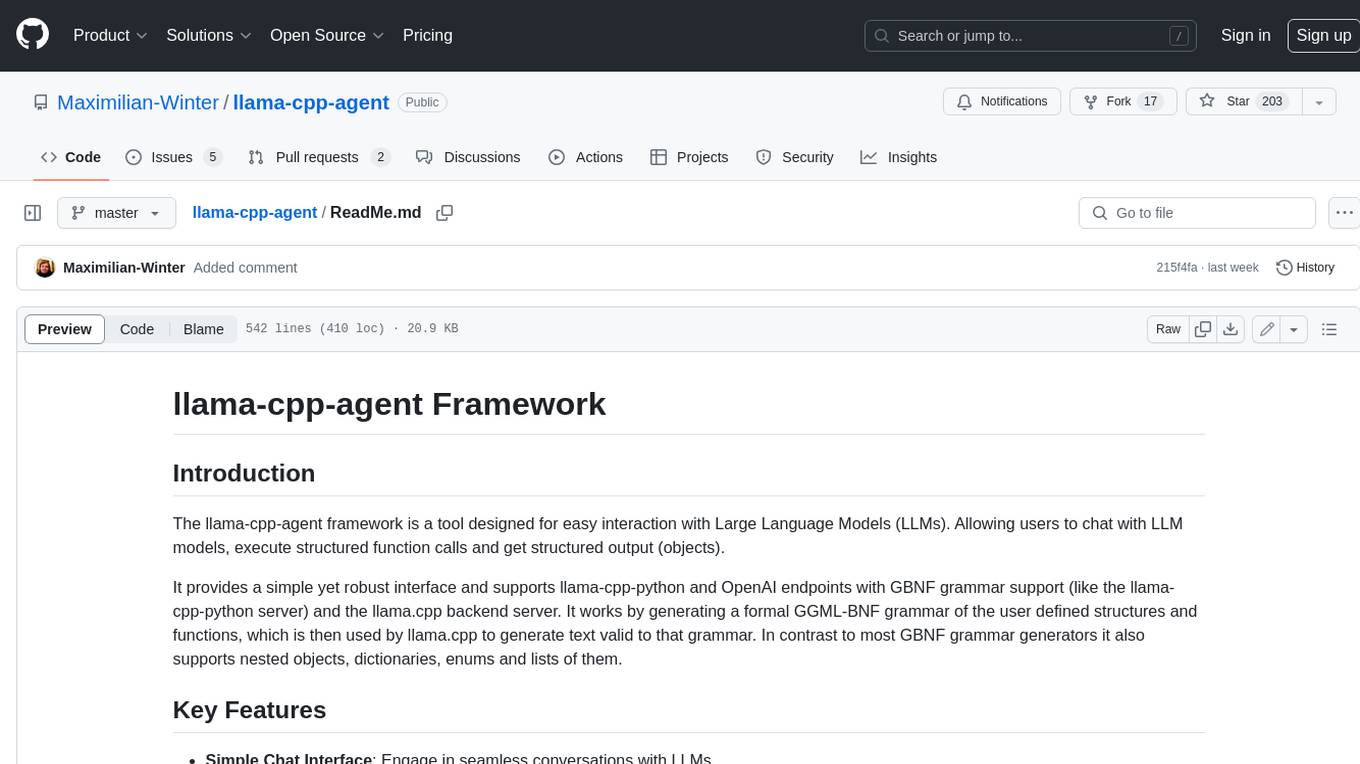
llama-cpp-agent
The llama-cpp-agent framework is a tool designed for easy interaction with Large Language Models (LLMs). Allowing users to chat with LLM models, execute structured function calls and get structured output (objects). It provides a simple yet robust interface and supports llama-cpp-python and OpenAI endpoints with GBNF grammar support (like the llama-cpp-python server) and the llama.cpp backend server. It works by generating a formal GGML-BNF grammar of the user defined structures and functions, which is then used by llama.cpp to generate text valid to that grammar. In contrast to most GBNF grammar generators it also supports nested objects, dictionaries, enums and lists of them.

ebook-mcp
Ebook-MCP is a powerful Model Context Protocol (MCP) server designed for processing electronic books. It provides standardized APIs for seamless integration between LLM applications and e-book processing capabilities. The tool supports EPUB and PDF formats, enabling users to manage their digital library, have interactive reading experiences, support active learning, and easily navigate content through natural language queries. By bridging traditional e-books with AI capabilities, Ebook-MCP enhances the value users can extract from their digital reading materials.
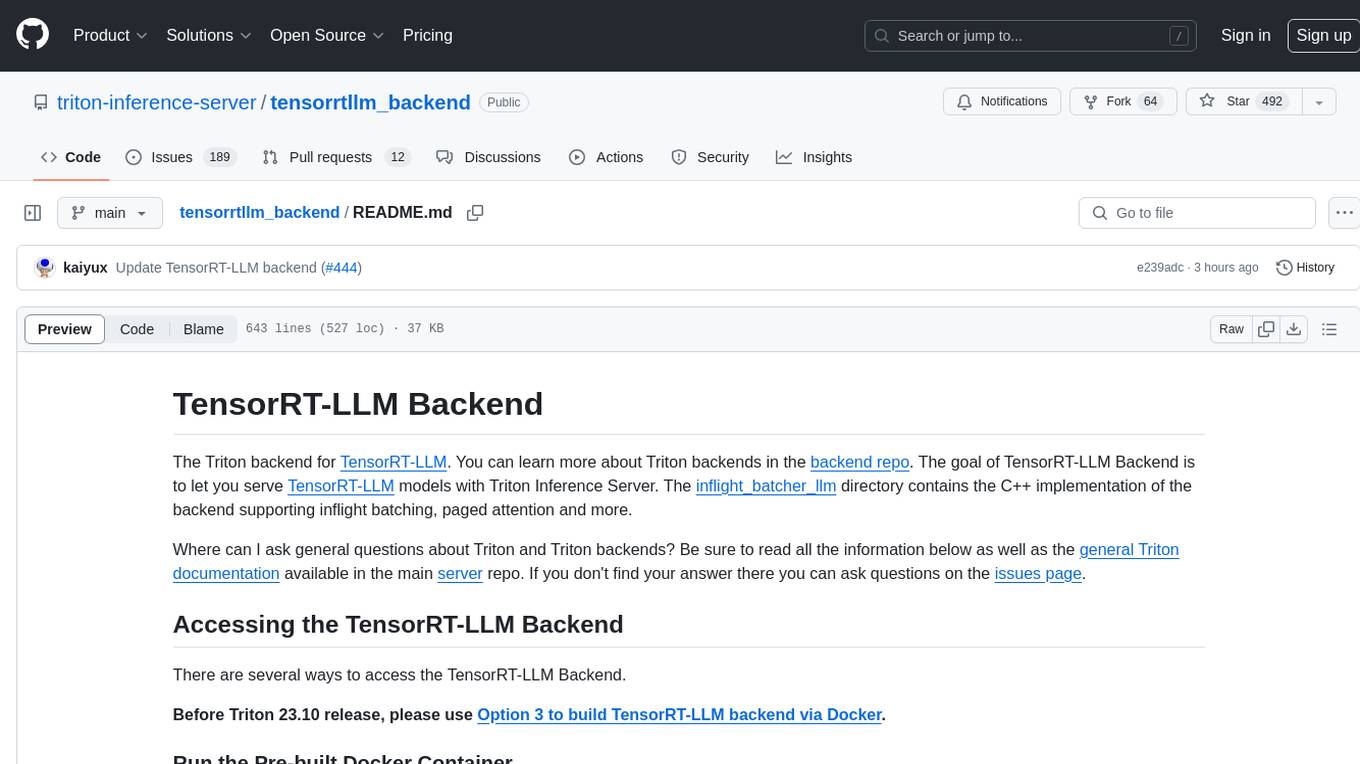
tensorrtllm_backend
The TensorRT-LLM Backend is a Triton backend designed to serve TensorRT-LLM models with Triton Inference Server. It supports features like inflight batching, paged attention, and more. Users can access the backend through pre-built Docker containers or build it using scripts provided in the repository. The backend can be used to create models for tasks like tokenizing, inferencing, de-tokenizing, ensemble modeling, and more. Users can interact with the backend using provided client scripts and query the server for metrics related to request handling, memory usage, KV cache blocks, and more. Testing for the backend can be done following the instructions in the 'ci/README.md' file.
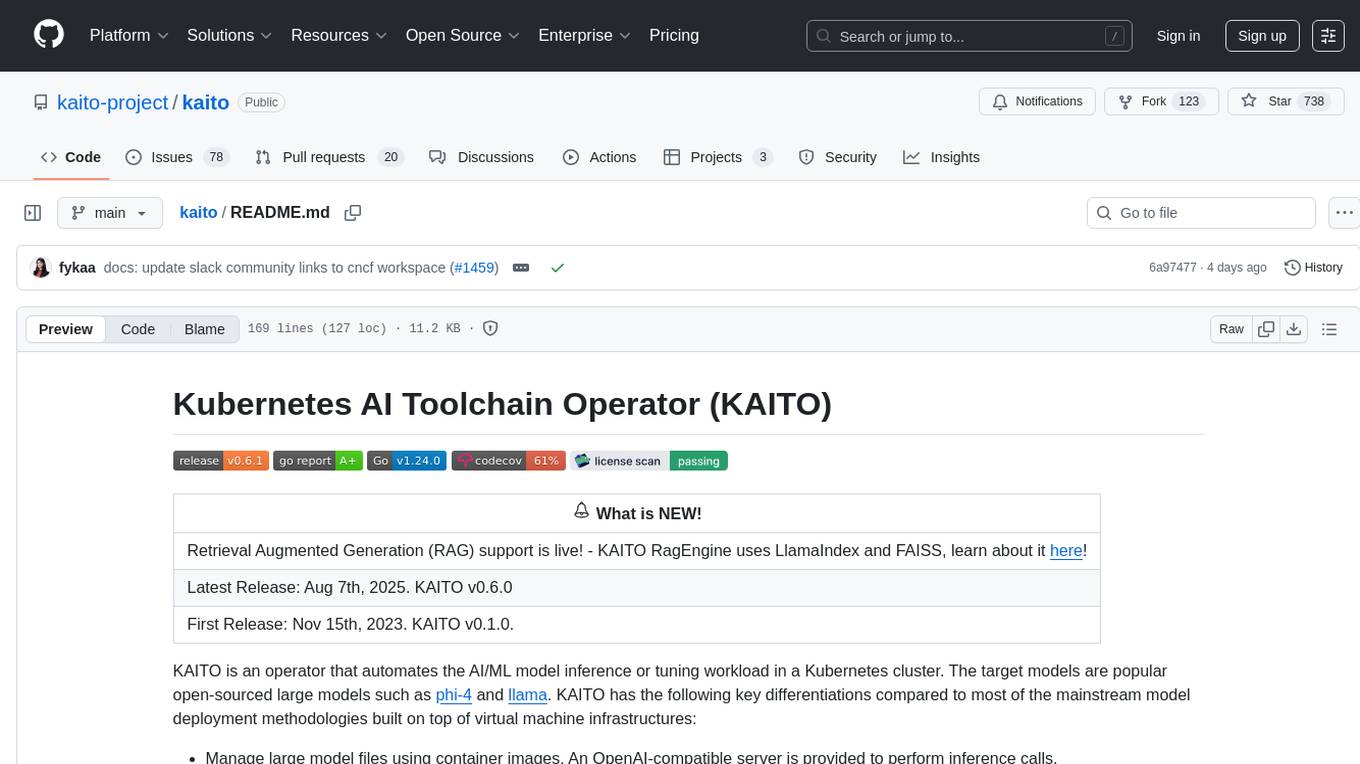
kaito
KAITO is an operator that automates the AI/ML model inference or tuning workload in a Kubernetes cluster. It manages large model files using container images, provides preset configurations to avoid adjusting workload parameters based on GPU hardware, supports popular open-sourced inference runtimes, auto-provisions GPU nodes based on model requirements, and hosts large model images in the public Microsoft Container Registry. Using KAITO simplifies the workflow of onboarding large AI inference models in Kubernetes.
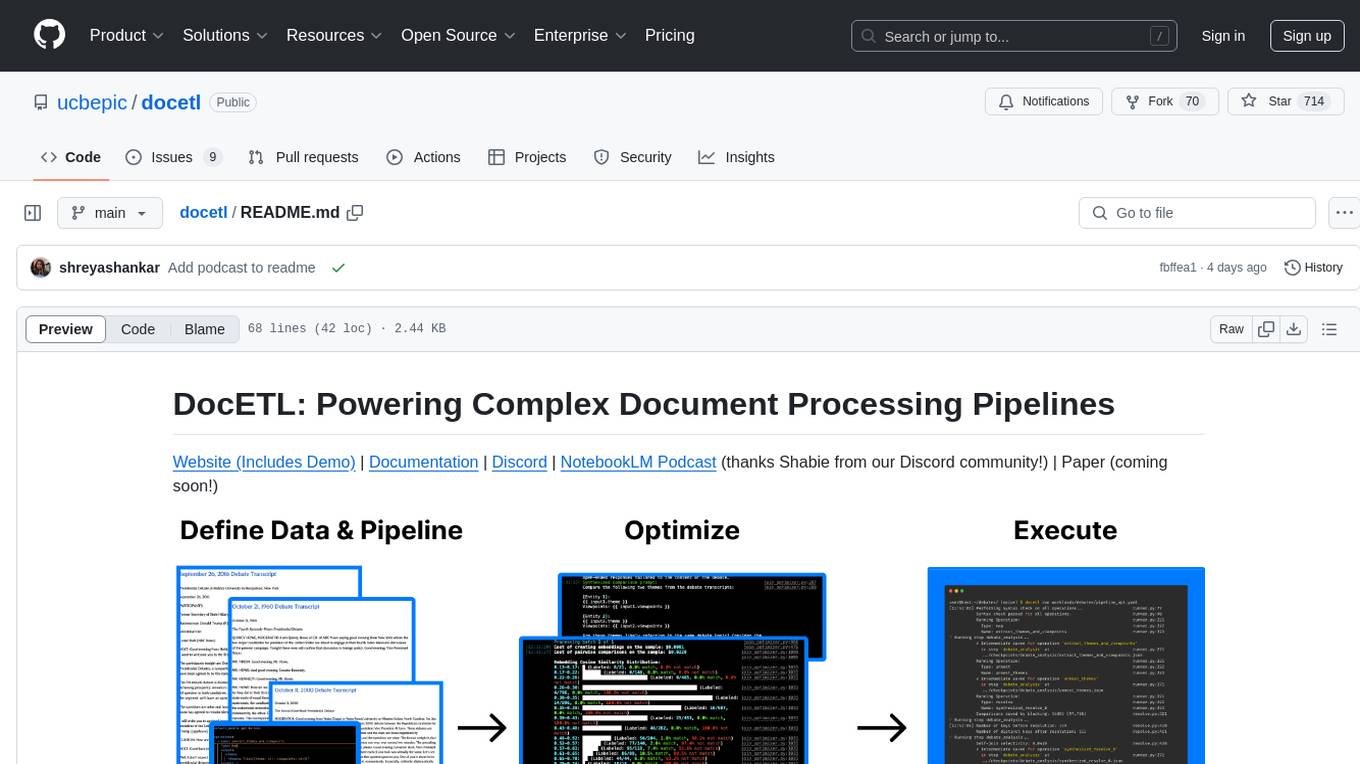
docetl
DocETL is a tool for creating and executing data processing pipelines, especially suited for complex document processing tasks. It offers a low-code, declarative YAML interface to define LLM-powered operations on complex data. Ideal for maximizing correctness and output quality for semantic processing on a collection of data, representing complex tasks via map-reduce, maximizing LLM accuracy, handling long documents, and automating task retries based on validation criteria.
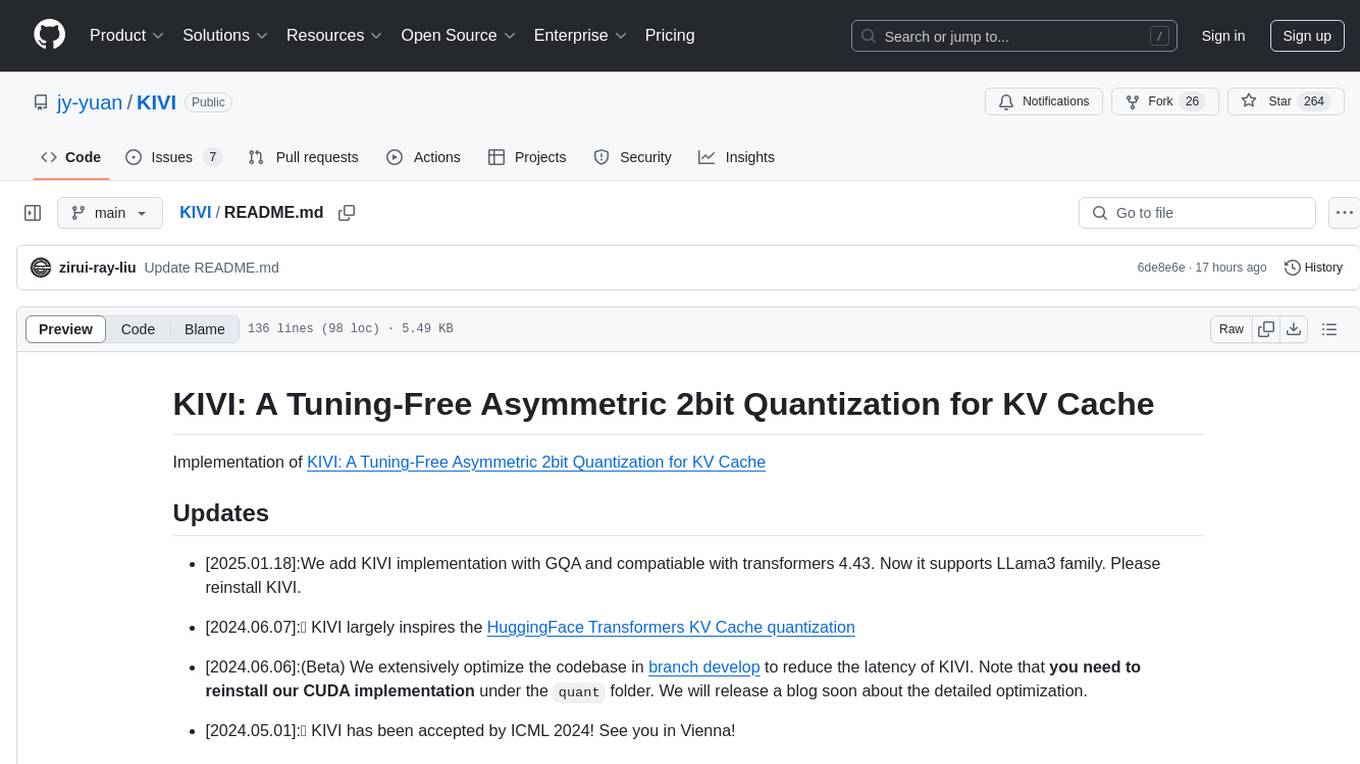
KIVI
KIVI is a plug-and-play 2bit KV cache quantization algorithm optimizing memory usage by quantizing key cache per-channel and value cache per-token to 2bit. It enables LLMs to maintain quality while reducing memory usage, allowing larger batch sizes and increasing throughput in real LLM inference workloads.
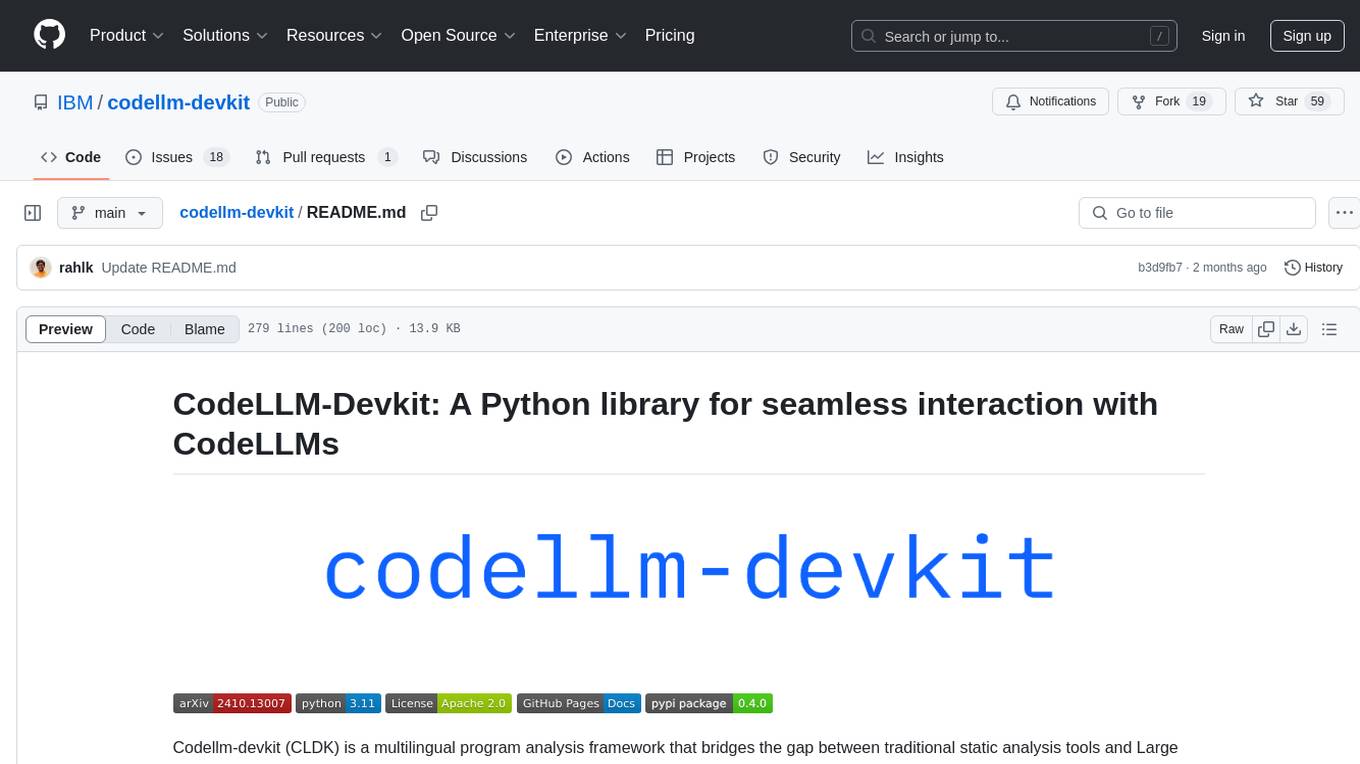
codellm-devkit
Codellm-devkit (CLDK) is a Python library that serves as a multilingual program analysis framework bridging traditional static analysis tools and Large Language Models (LLMs) specialized for code (CodeLLMs). It simplifies the process of analyzing codebases across multiple programming languages, enabling the extraction of meaningful insights and facilitating LLM-based code analysis. The library provides a unified interface for integrating outputs from various analysis tools and preparing them for effective use by CodeLLMs. Codellm-devkit aims to enable the development and experimentation of robust analysis pipelines that combine traditional program analysis tools and CodeLLMs, reducing friction in multi-language code analysis and ensuring compatibility across different tools and LLM platforms. It is designed to seamlessly integrate with popular analysis tools like WALA, Tree-sitter, LLVM, and CodeQL, acting as a crucial intermediary layer for efficient communication between these tools and CodeLLMs. The project is continuously evolving to include new tools and frameworks, maintaining its versatility for code analysis and LLM integration.
For similar tasks

wacat
wacat is a tool designed to challenge web applications by simulating chaotic user behavior, such as random navigation, form input, and button clicks. It also incorporates AI-powered error detection, supporting features like detecting error messages, generating AI-driven content, and detecting HTTP errors and console log errors. wacat can be configured for various testing scenarios, including authentication, excluding specific pages, running in headless mode, and setting wait times and timeouts. It is built using TypeScript, oclif, Playwright, and Next.js for test applications.
For similar jobs
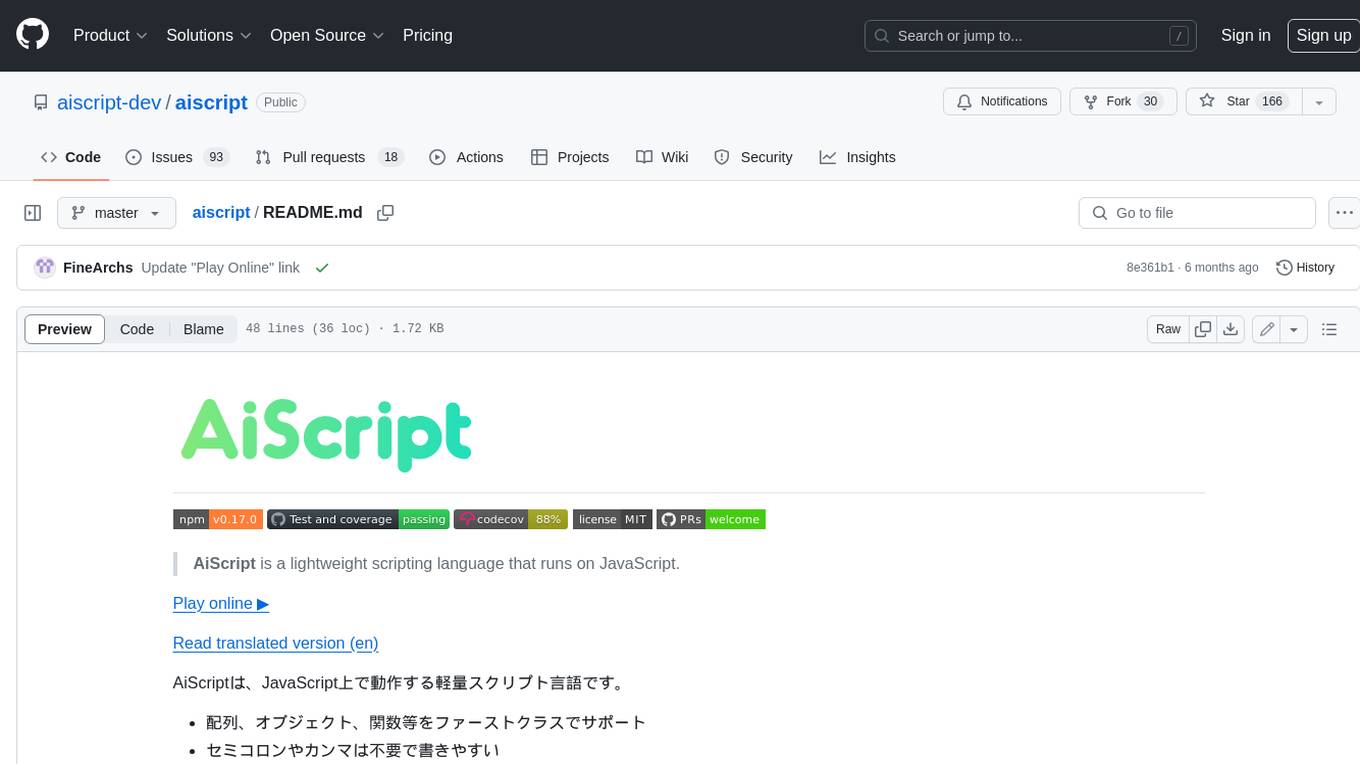
aiscript
AiScript is a lightweight scripting language that runs on JavaScript. It supports arrays, objects, and functions as first-class citizens, and is easy to write without the need for semicolons or commas. AiScript runs in a secure sandbox environment, preventing infinite loops from freezing the host. It also allows for easy provision of variables and functions from the host.
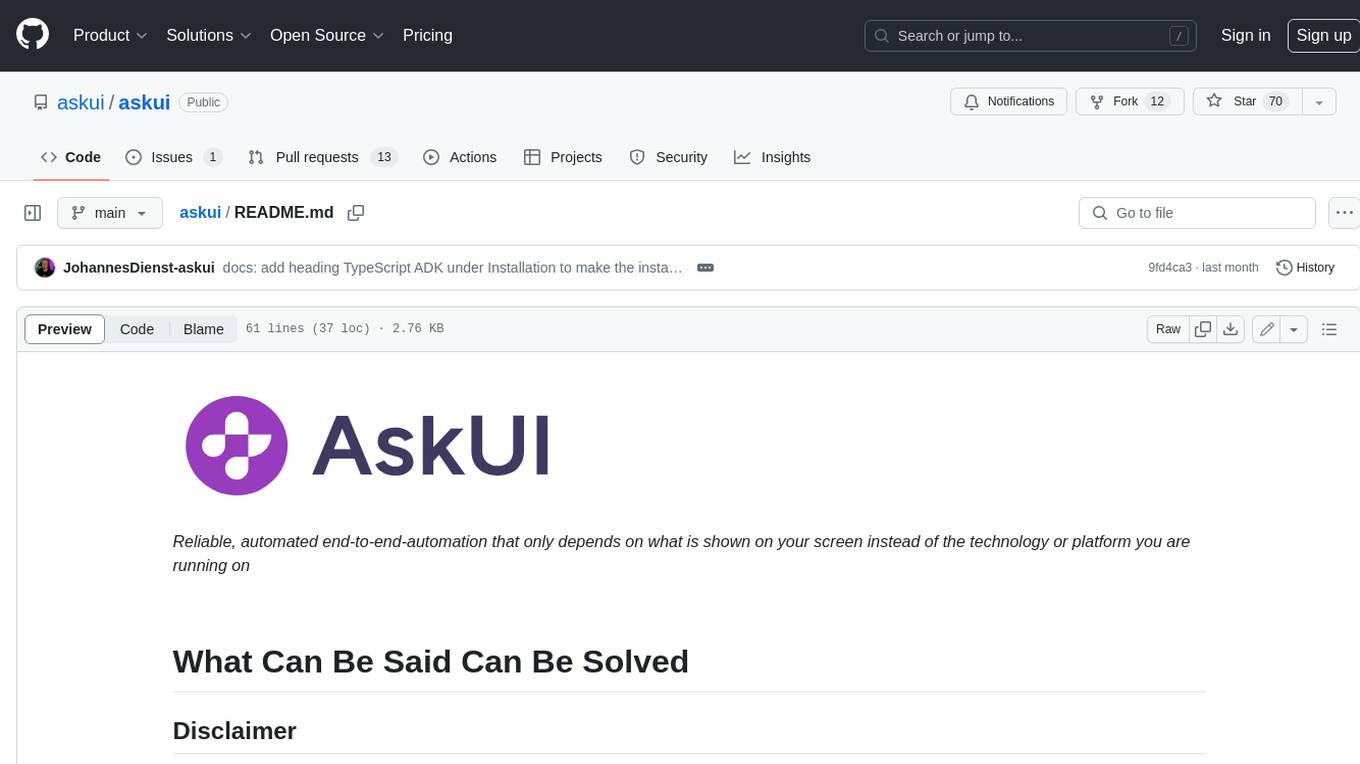
askui
AskUI is a reliable, automated end-to-end automation tool that only depends on what is shown on your screen instead of the technology or platform you are running on.
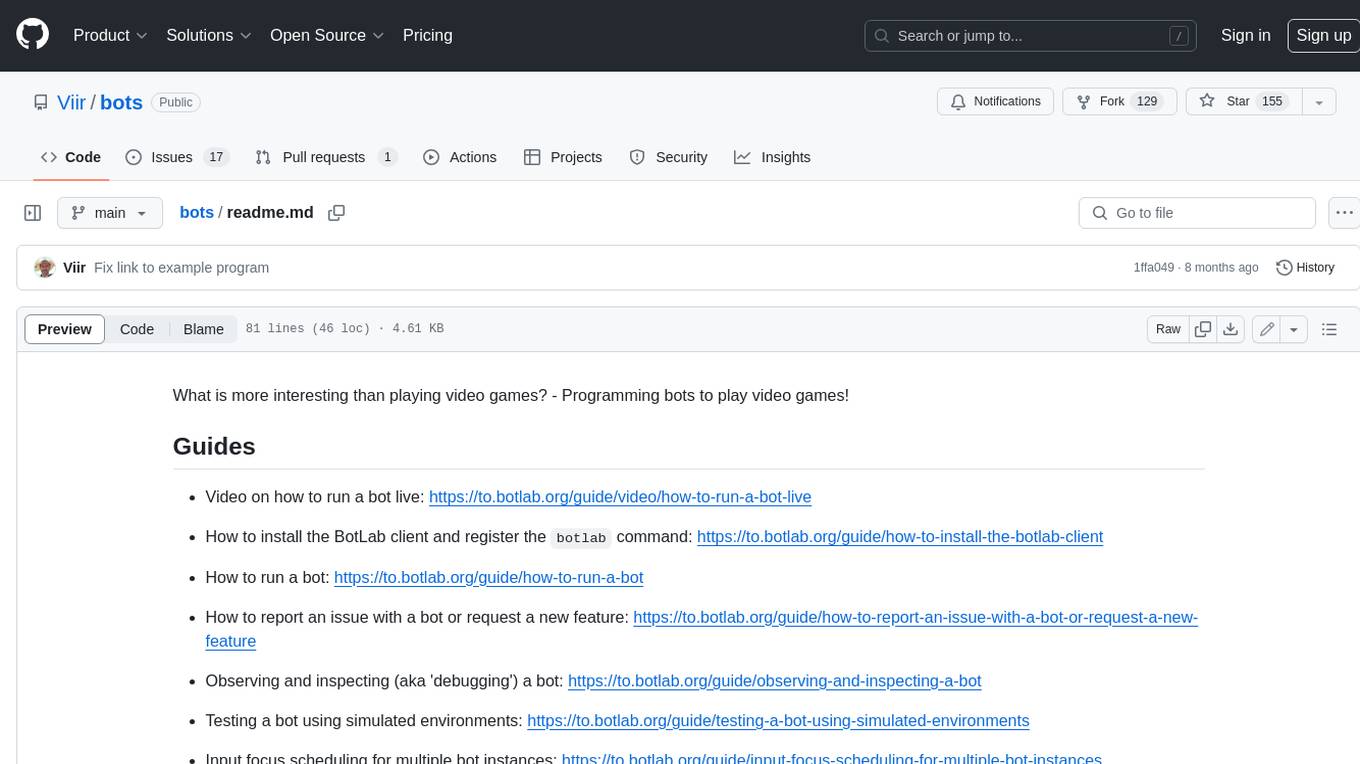
bots
The 'bots' repository is a collection of guides, tools, and example bots for programming bots to play video games. It provides resources on running bots live, installing the BotLab client, debugging bots, testing bots in simulated environments, and more. The repository also includes example bots for games like EVE Online, Tribal Wars 2, and Elvenar. Users can learn about developing bots for specific games, syntax of the Elm programming language, and tools for memory reading development. Additionally, there are guides on bot programming, contributing to BotLab, and exploring Elm syntax and core library.
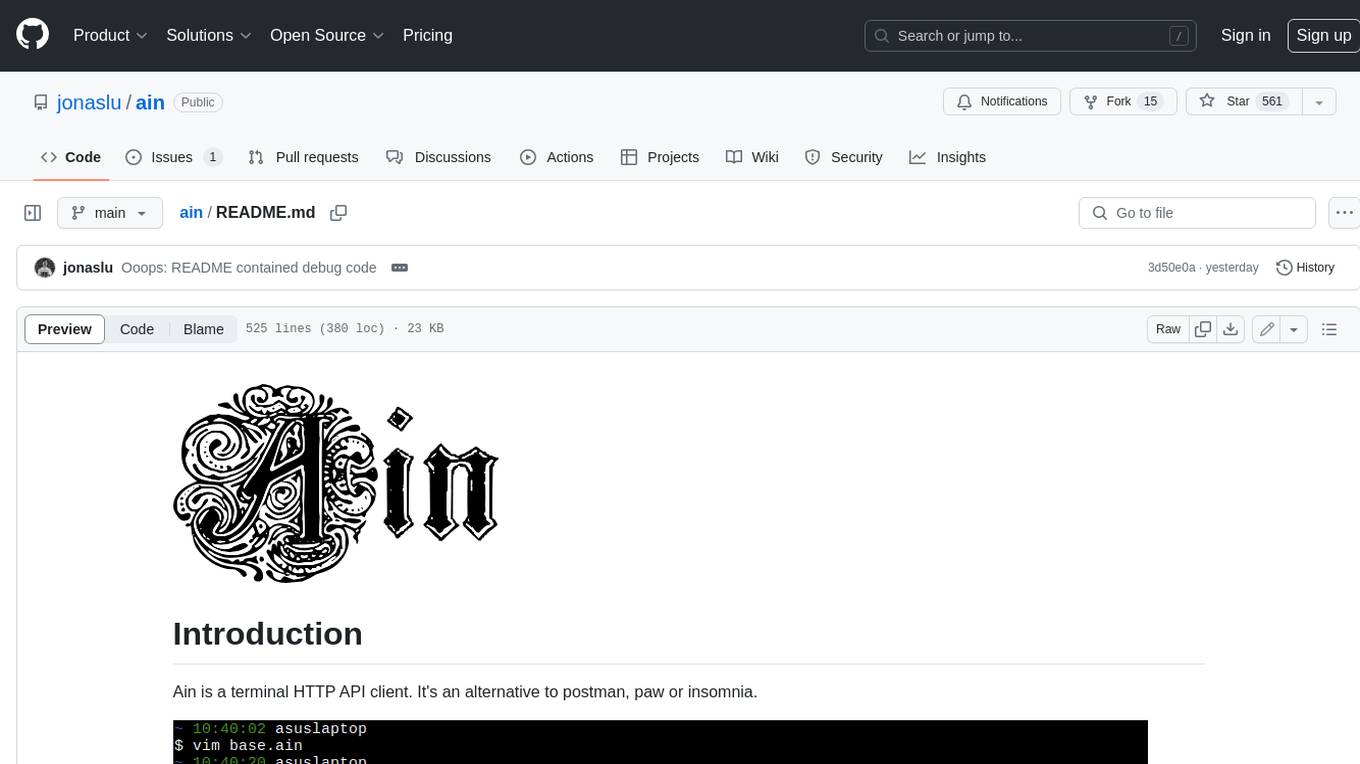
ain
Ain is a terminal HTTP API client designed for scripting input and processing output via pipes. It allows flexible organization of APIs using files and folders, supports shell-scripts and executables for common tasks, handles url-encoding, and enables sharing the resulting curl, wget, or httpie command-line. Users can put things that change in environment variables or .env-files, and pipe the API output for further processing. Ain targets users who work with many APIs using a simple file format and uses curl, wget, or httpie to make the actual calls.
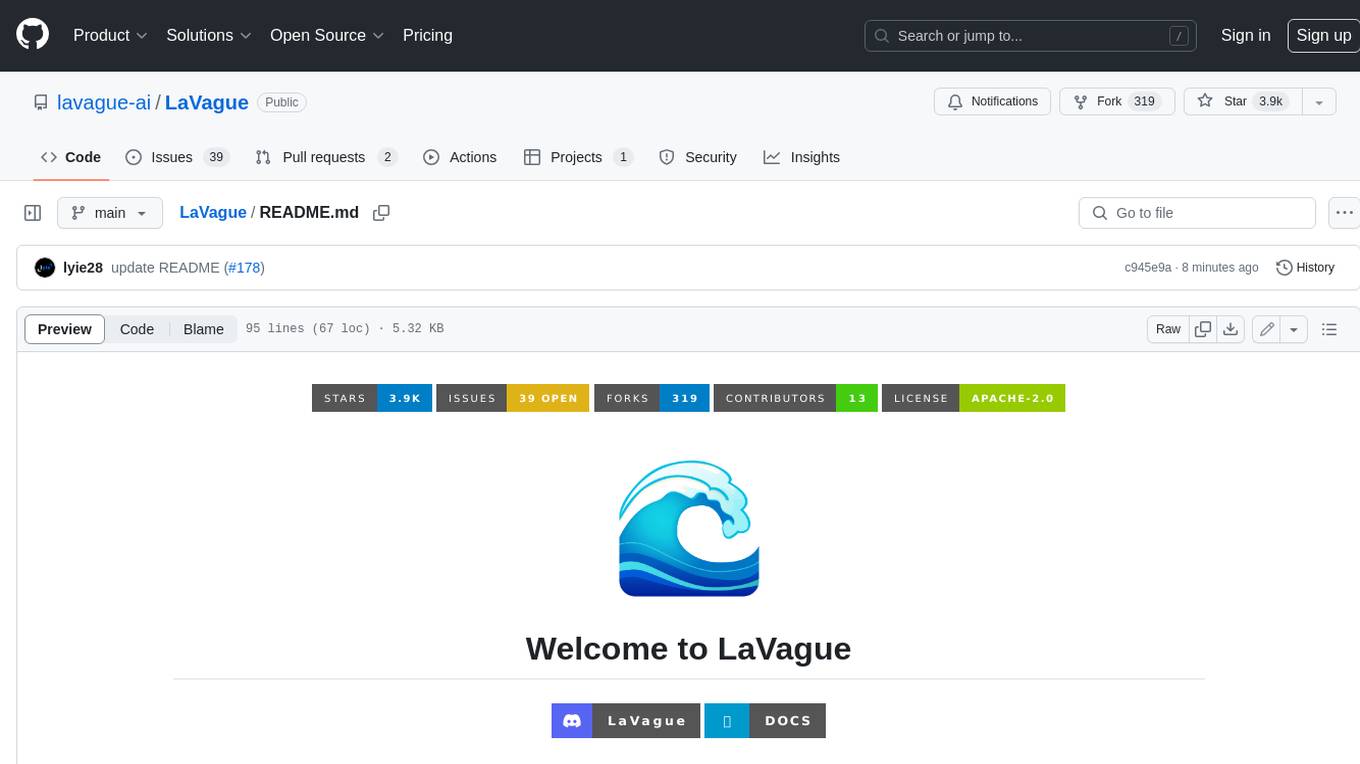
LaVague
LaVague is an open-source Large Action Model framework that uses advanced AI techniques to compile natural language instructions into browser automation code. It leverages Selenium or Playwright for browser actions. Users can interact with LaVague through an interactive Gradio interface to automate web interactions. The tool requires an OpenAI API key for default examples and offers a Playwright integration guide. Contributors can help by working on outlined tasks, submitting PRs, and engaging with the community on Discord. The project roadmap is available to track progress, but users should exercise caution when executing LLM-generated code using 'exec'.
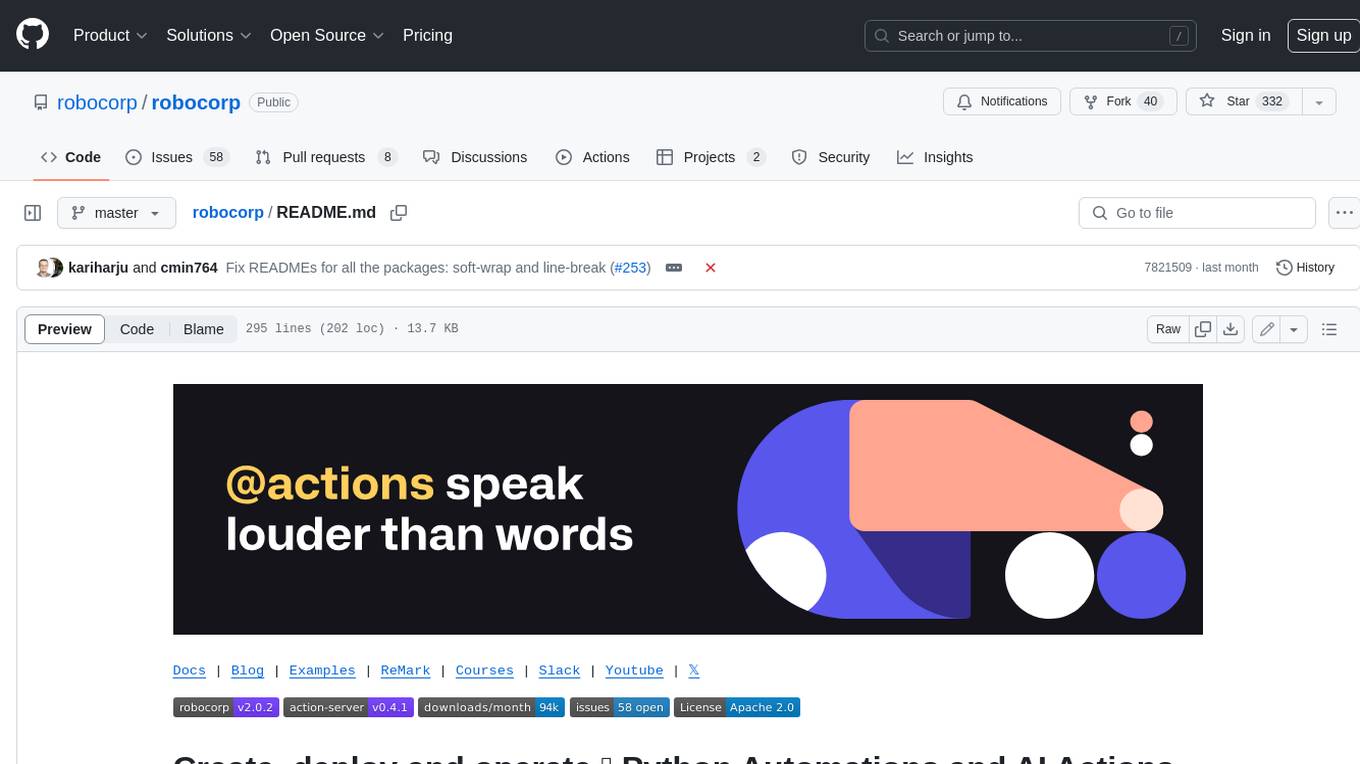
robocorp
Robocorp is a platform that allows users to create, deploy, and operate Python automations and AI actions. It provides an easy way to extend the capabilities of AI agents, assistants, and copilots with custom actions written in Python. Users can create and deploy tools, skills, loaders, and plugins that securely connect any AI Assistant platform to their data and applications. The Robocorp Action Server makes Python scripts compatible with ChatGPT and LangChain by automatically creating and exposing an API based on function declaration, type hints, and docstrings. It simplifies the process of developing and deploying AI actions, enabling users to interact with AI frameworks effortlessly.
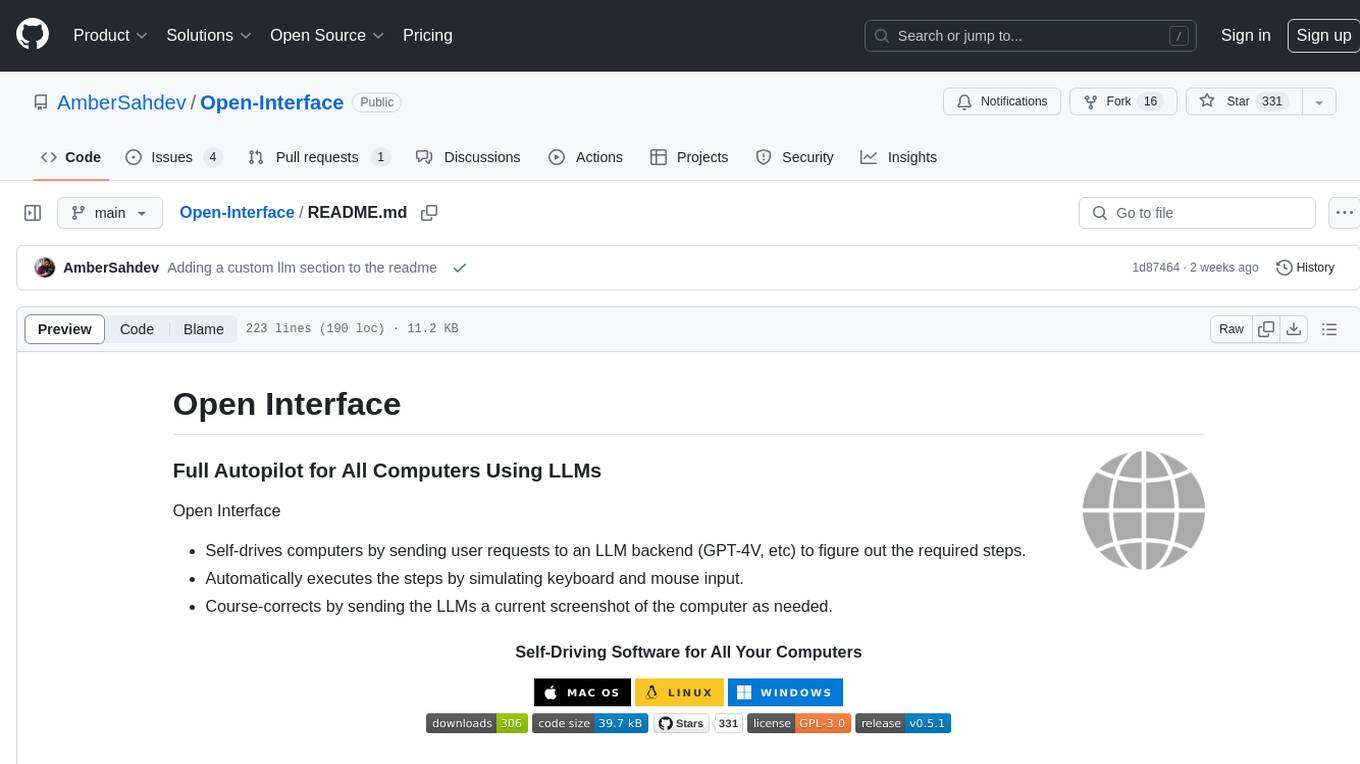
Open-Interface
Open Interface is a self-driving software that automates computer tasks by sending user requests to a language model backend (e.g., GPT-4V) and simulating keyboard and mouse inputs to execute the steps. It course-corrects by sending current screenshots to the language models. The tool supports MacOS, Linux, and Windows, and requires setting up the OpenAI API key for access to GPT-4V. It can automate tasks like creating meal plans, setting up custom language model backends, and more. Open Interface is currently not efficient in accurate spatial reasoning, tracking itself in tabular contexts, and navigating complex GUI-rich applications. Future improvements aim to enhance the tool's capabilities with better models trained on video walkthroughs. The tool is cost-effective, with user requests priced between $0.05 - $0.20, and offers features like interrupting the app and primary display visibility in multi-monitor setups.
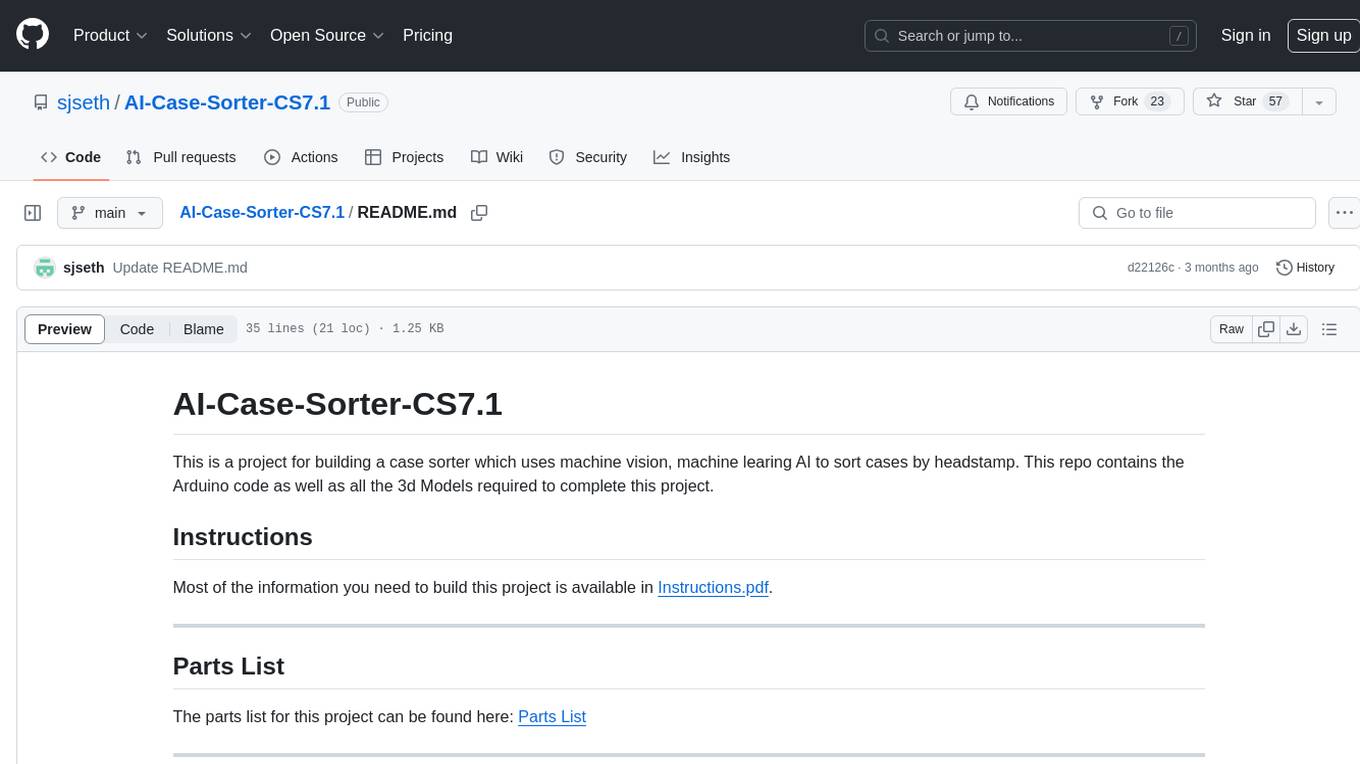
AI-Case-Sorter-CS7.1
AI-Case-Sorter-CS7.1 is a project focused on building a case sorter using machine vision and machine learning AI to sort cases by headstamp. The repository includes Arduino code and 3D models necessary for the project.




















